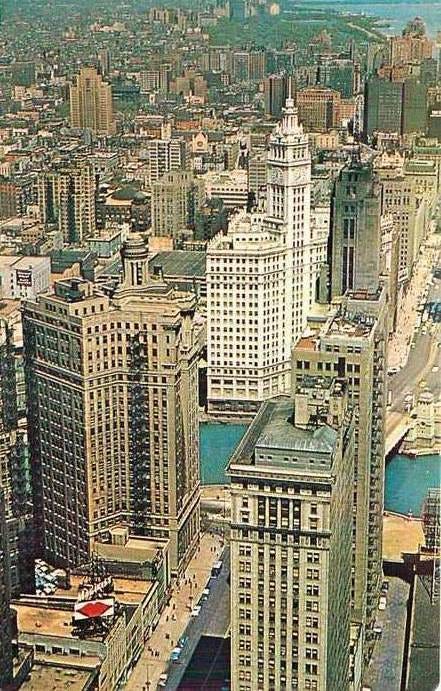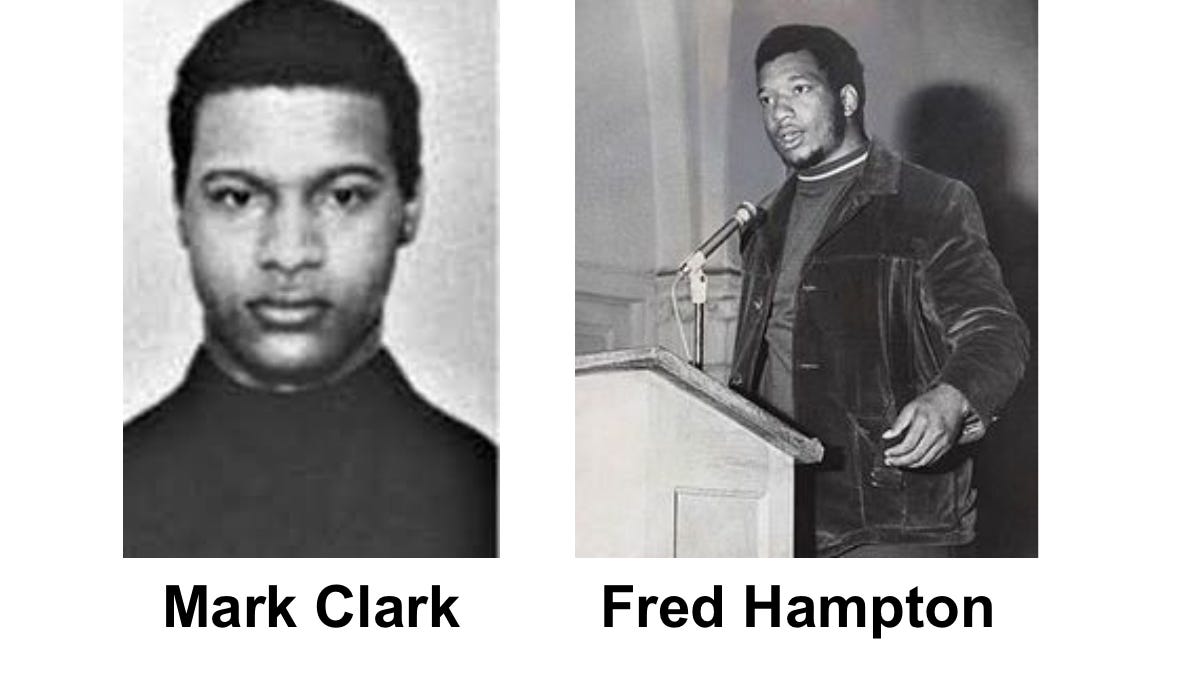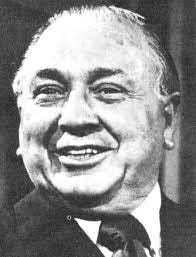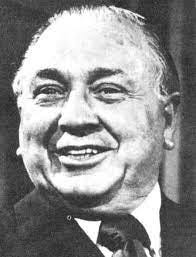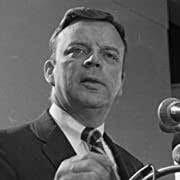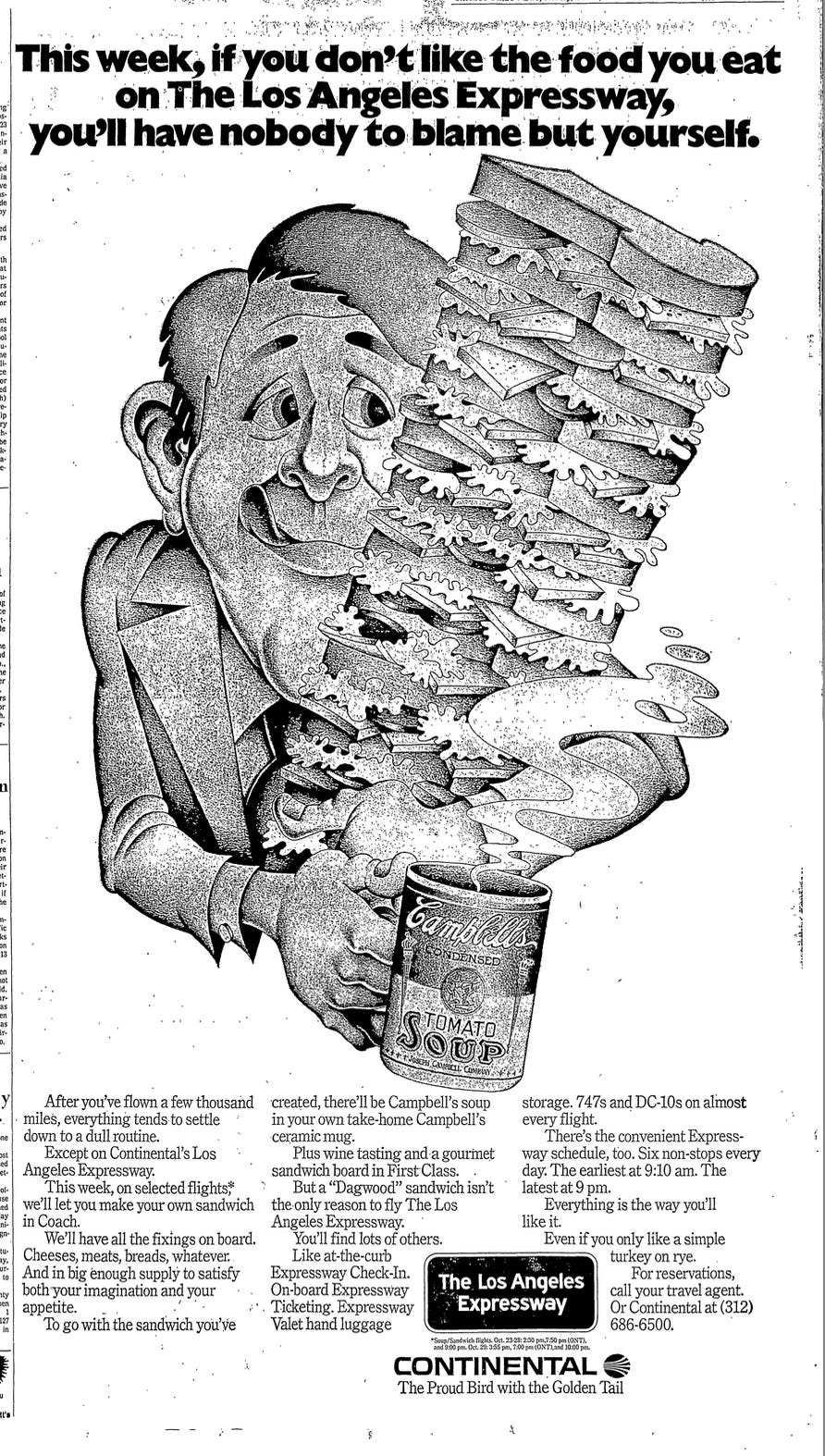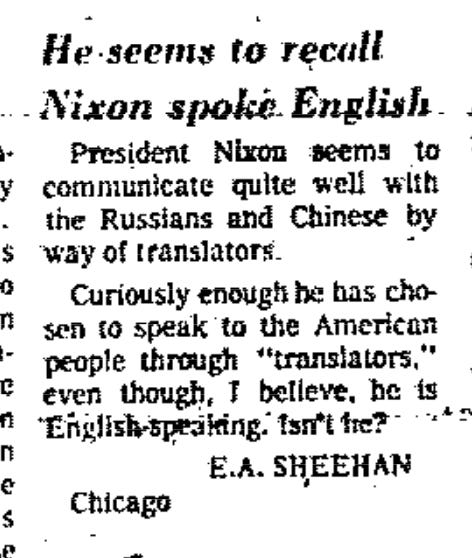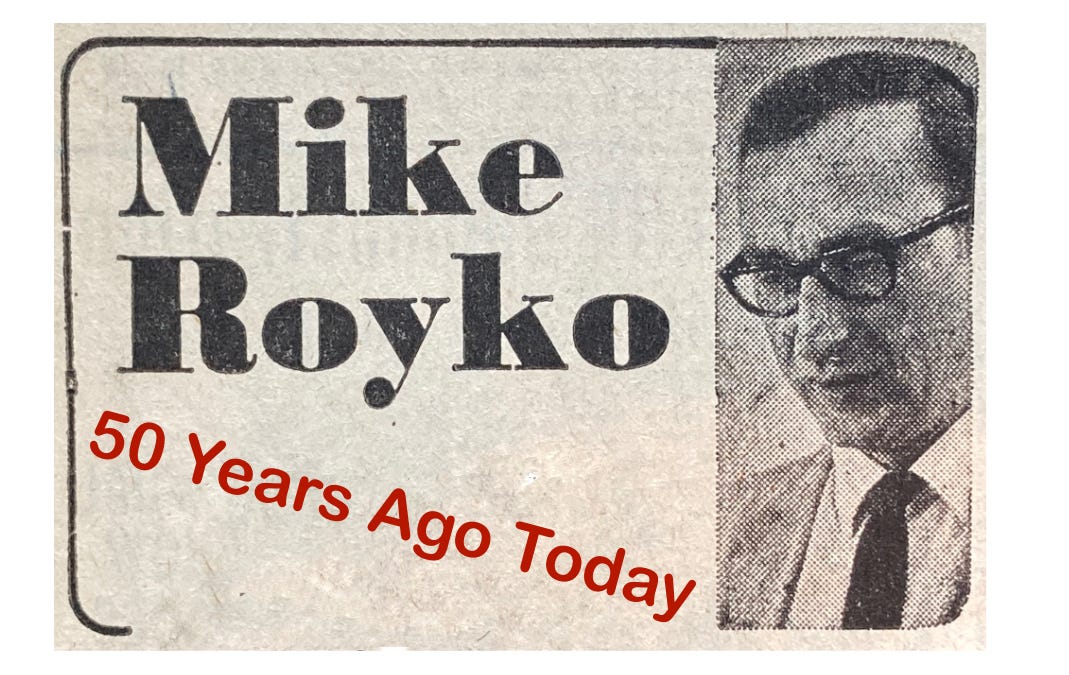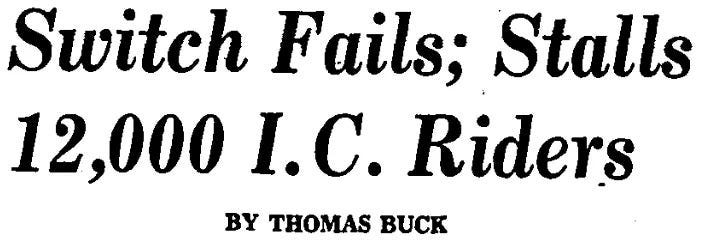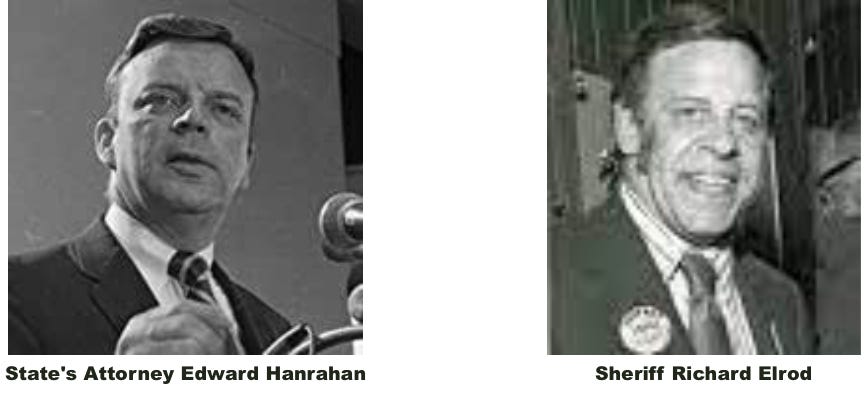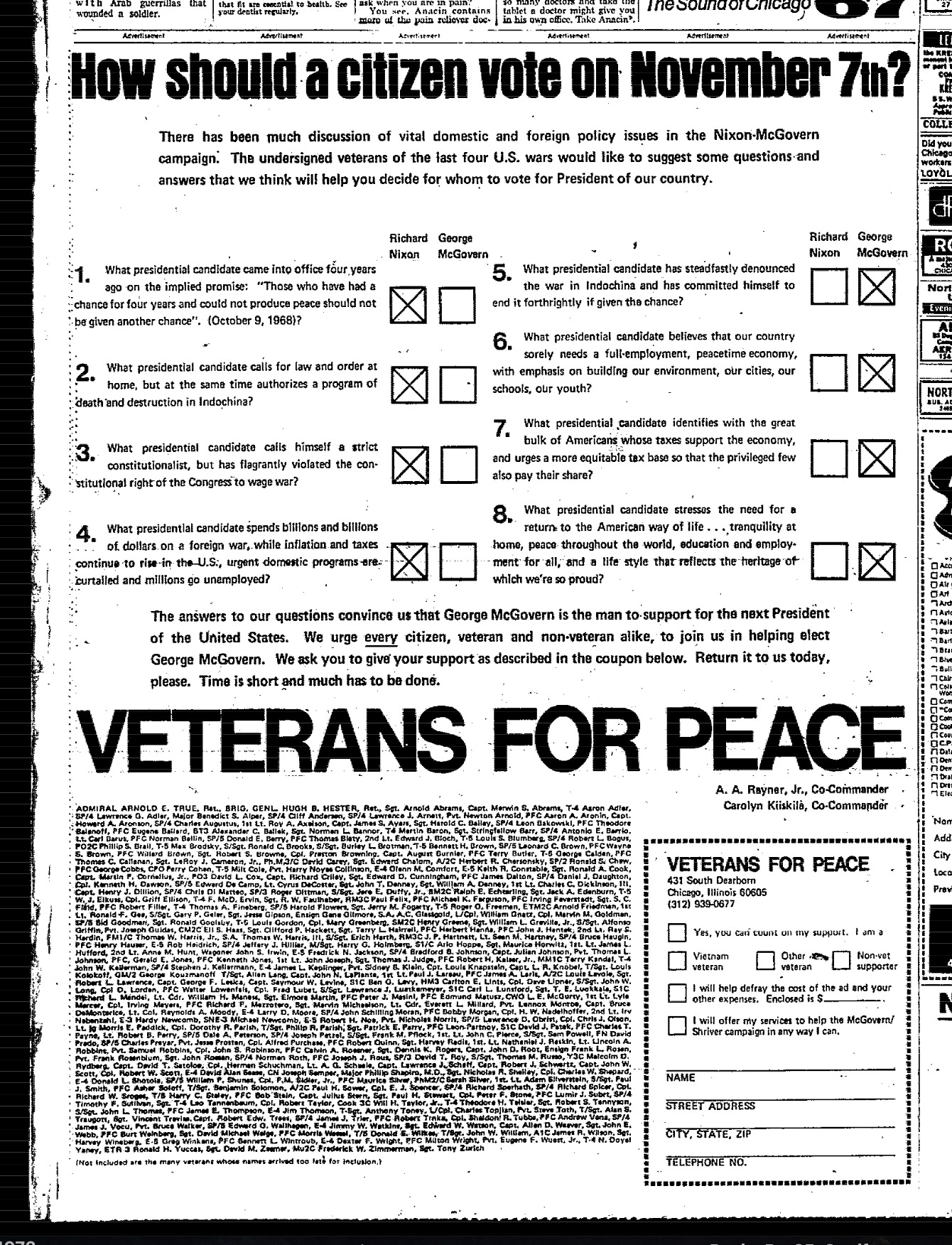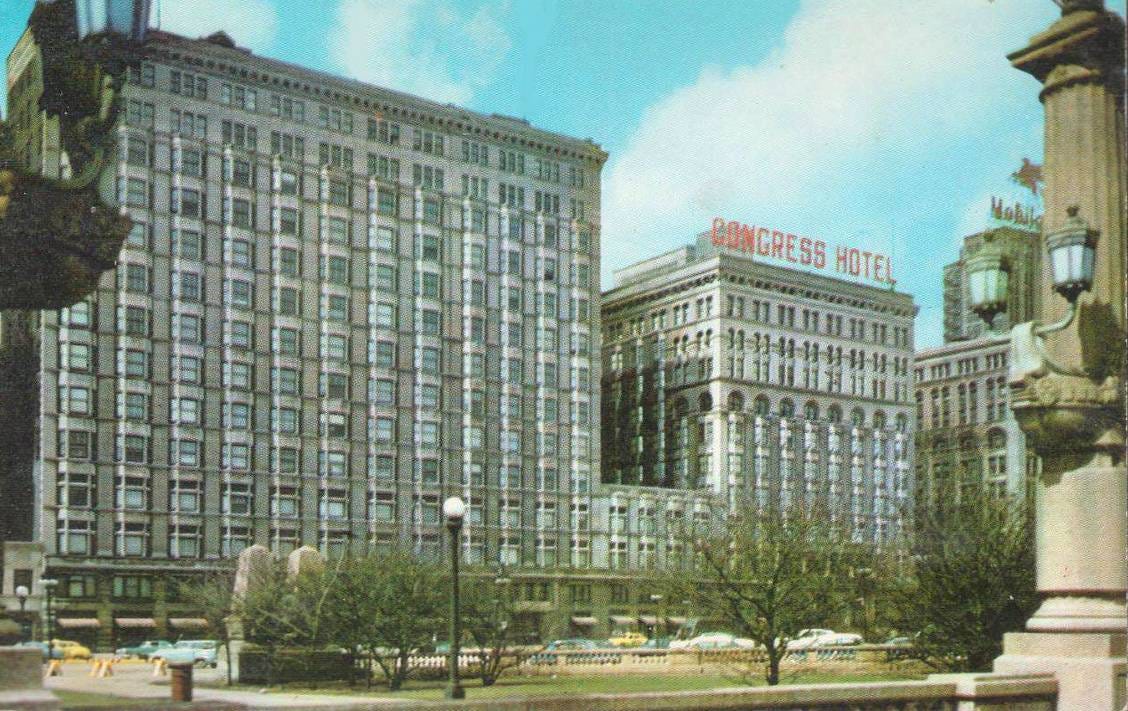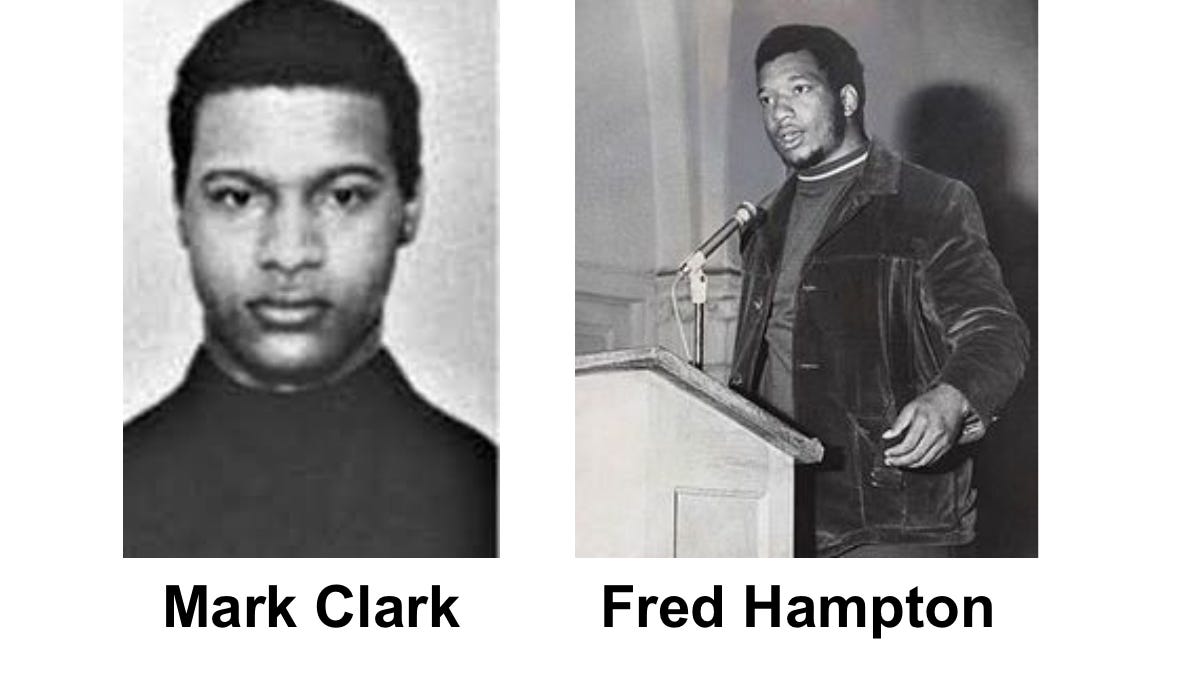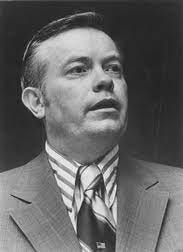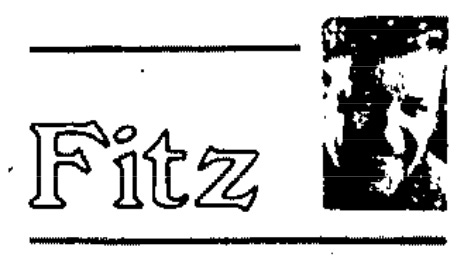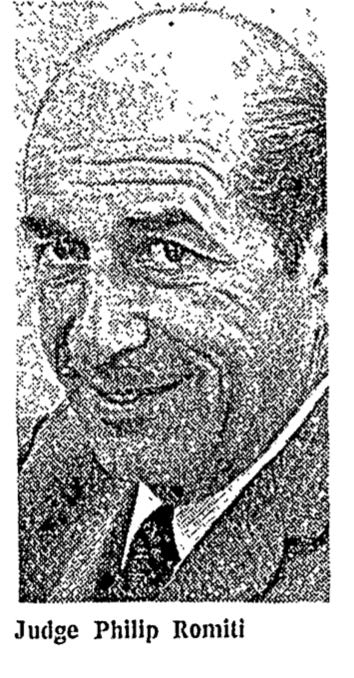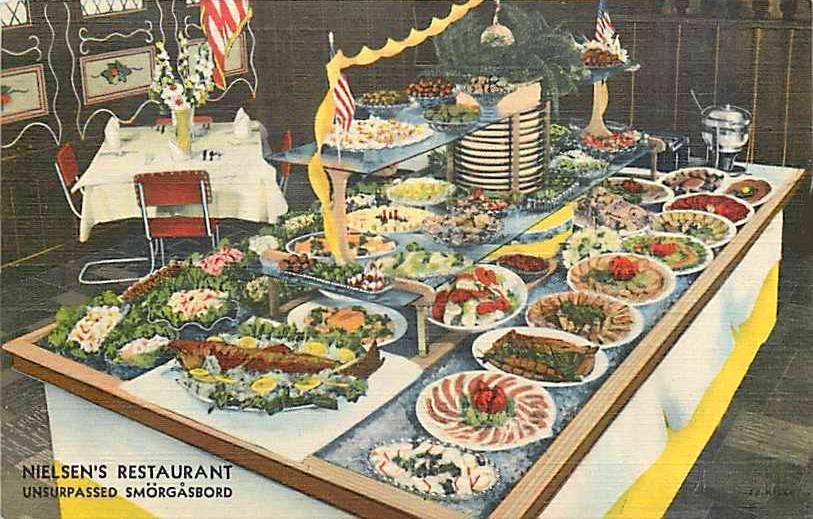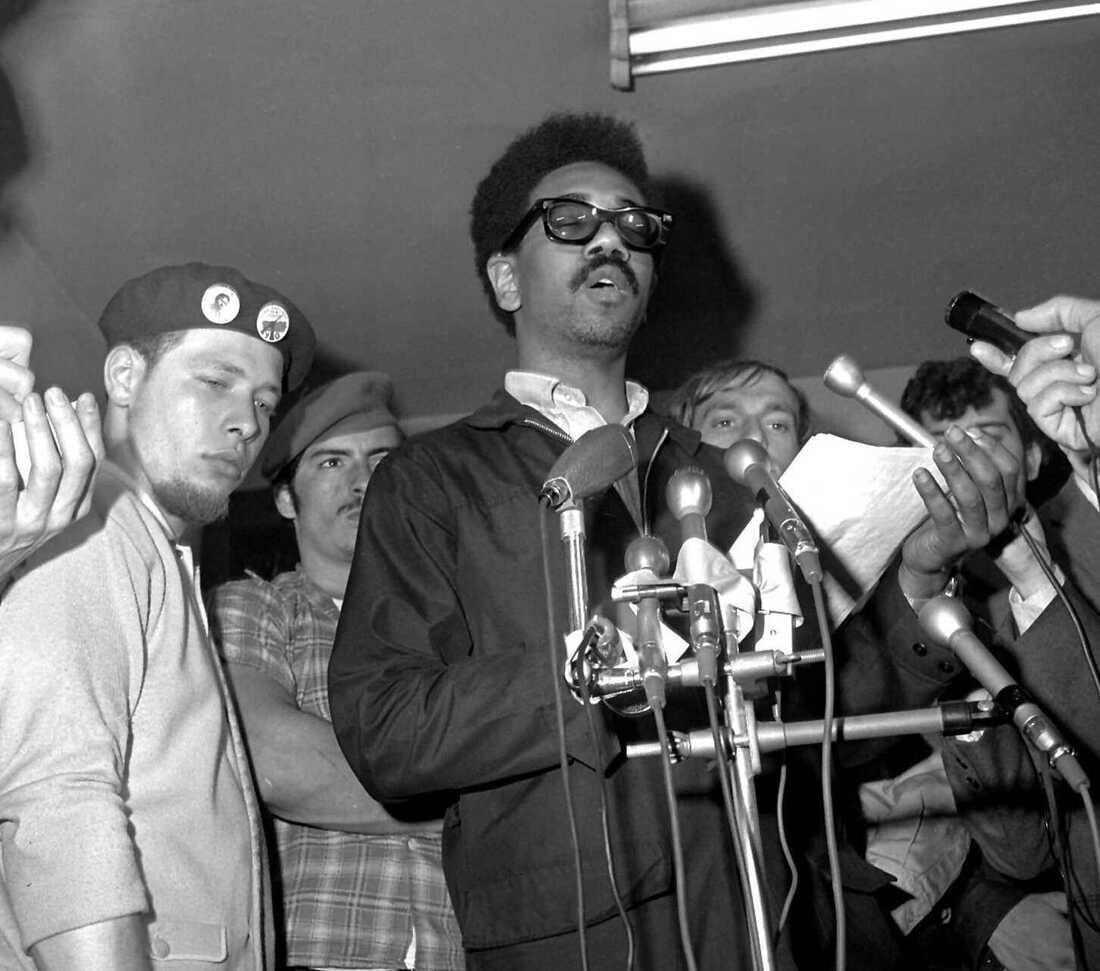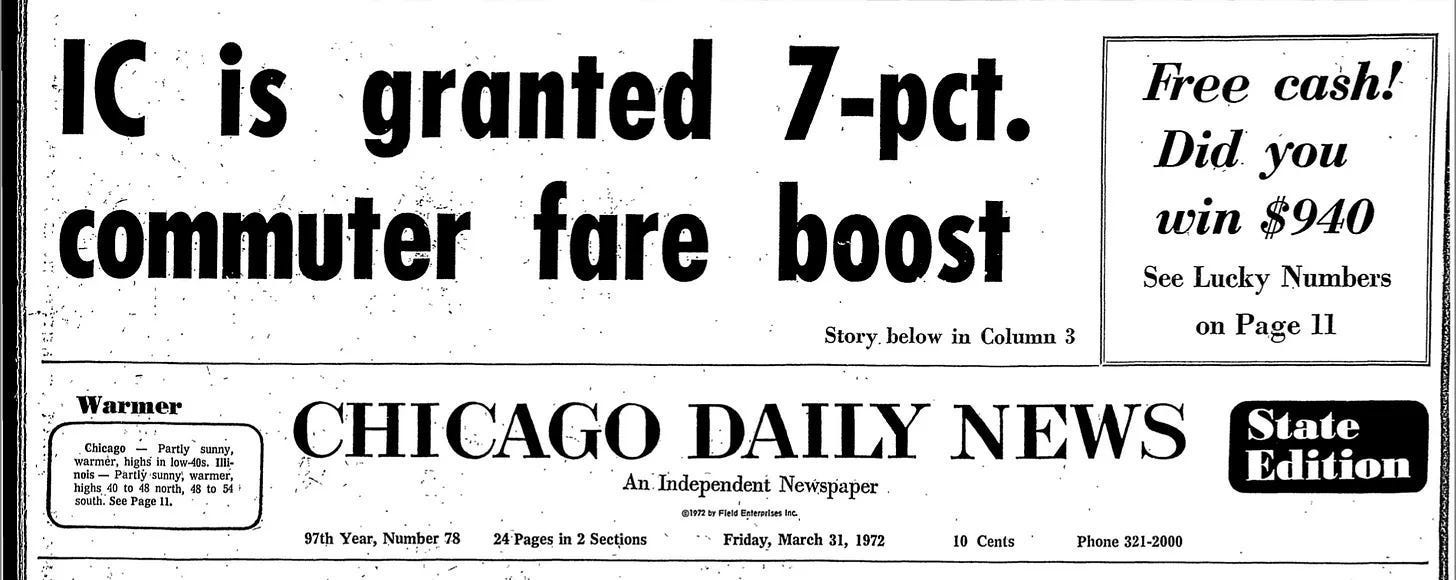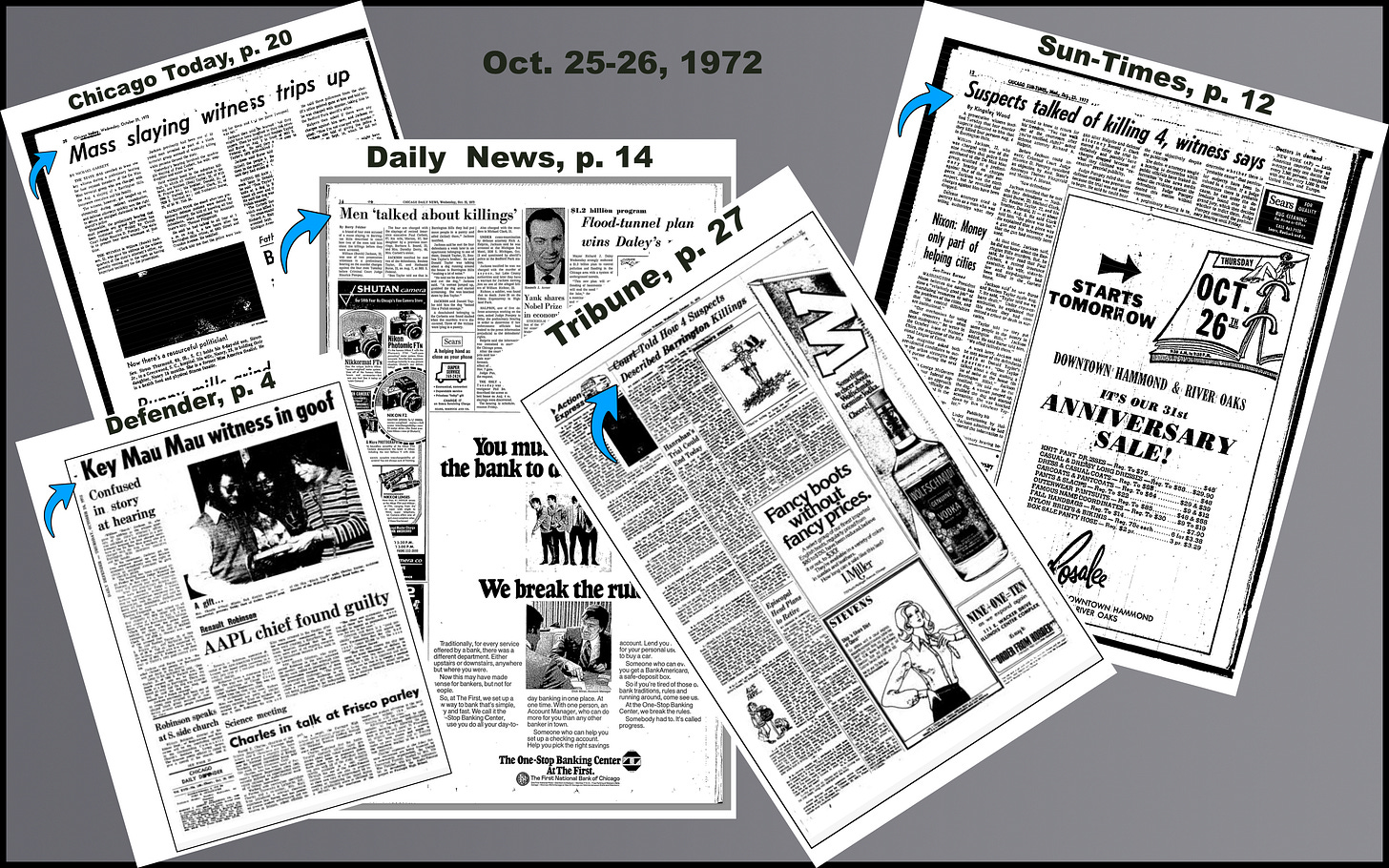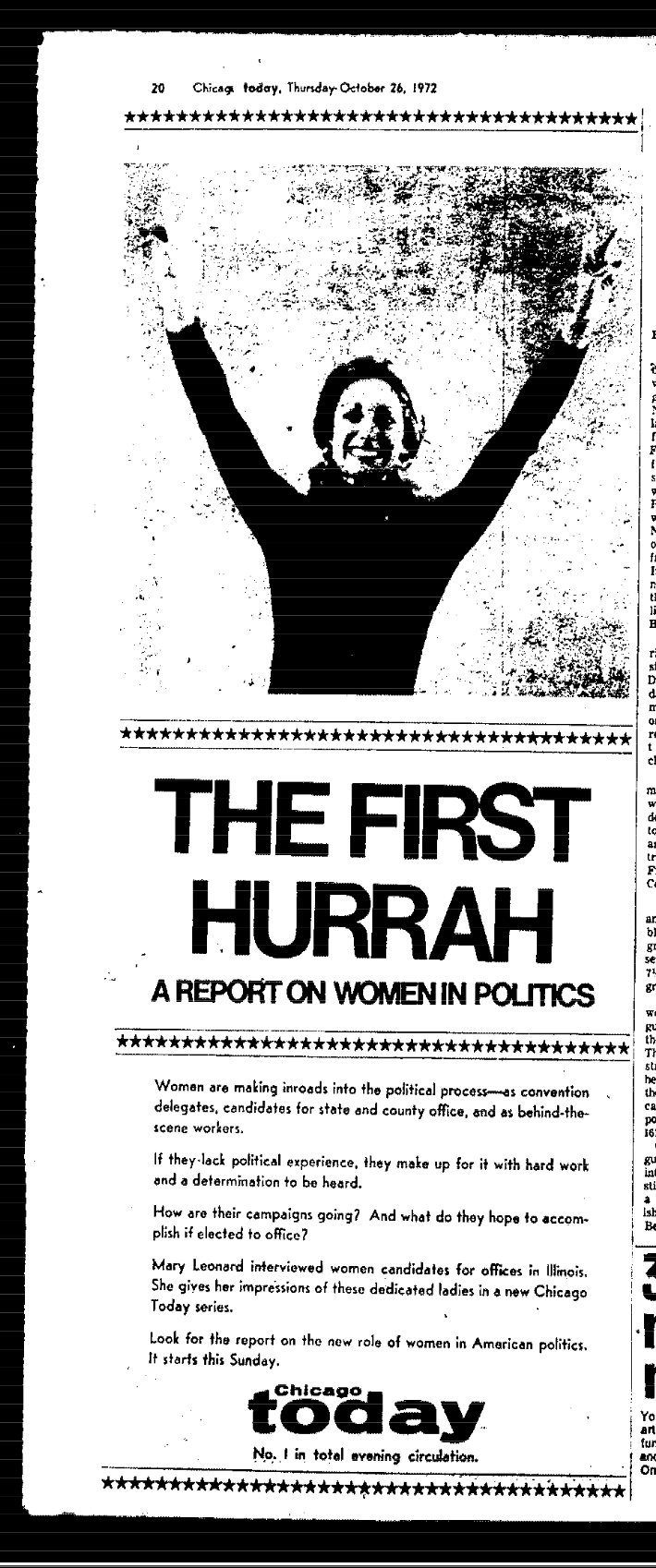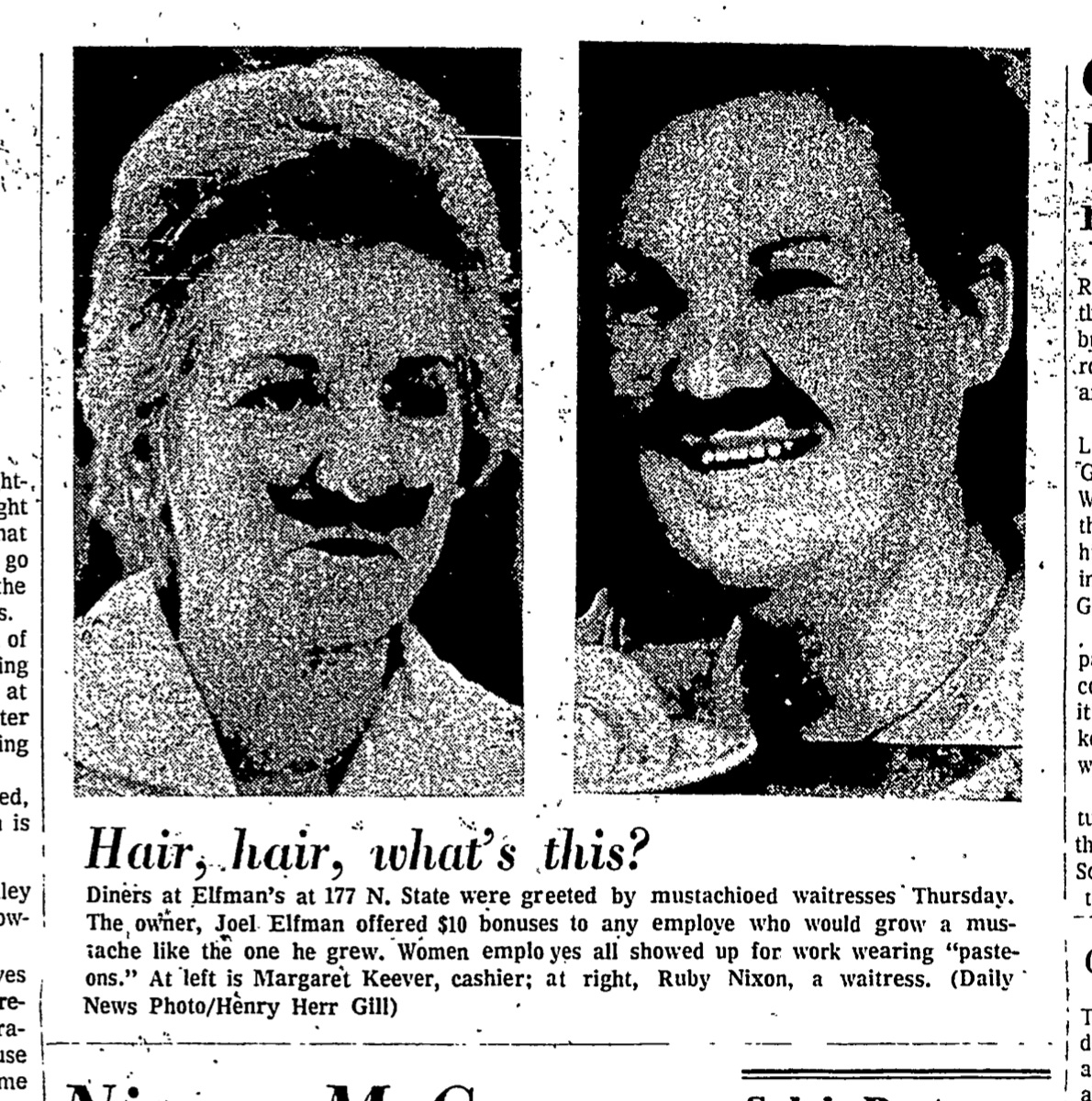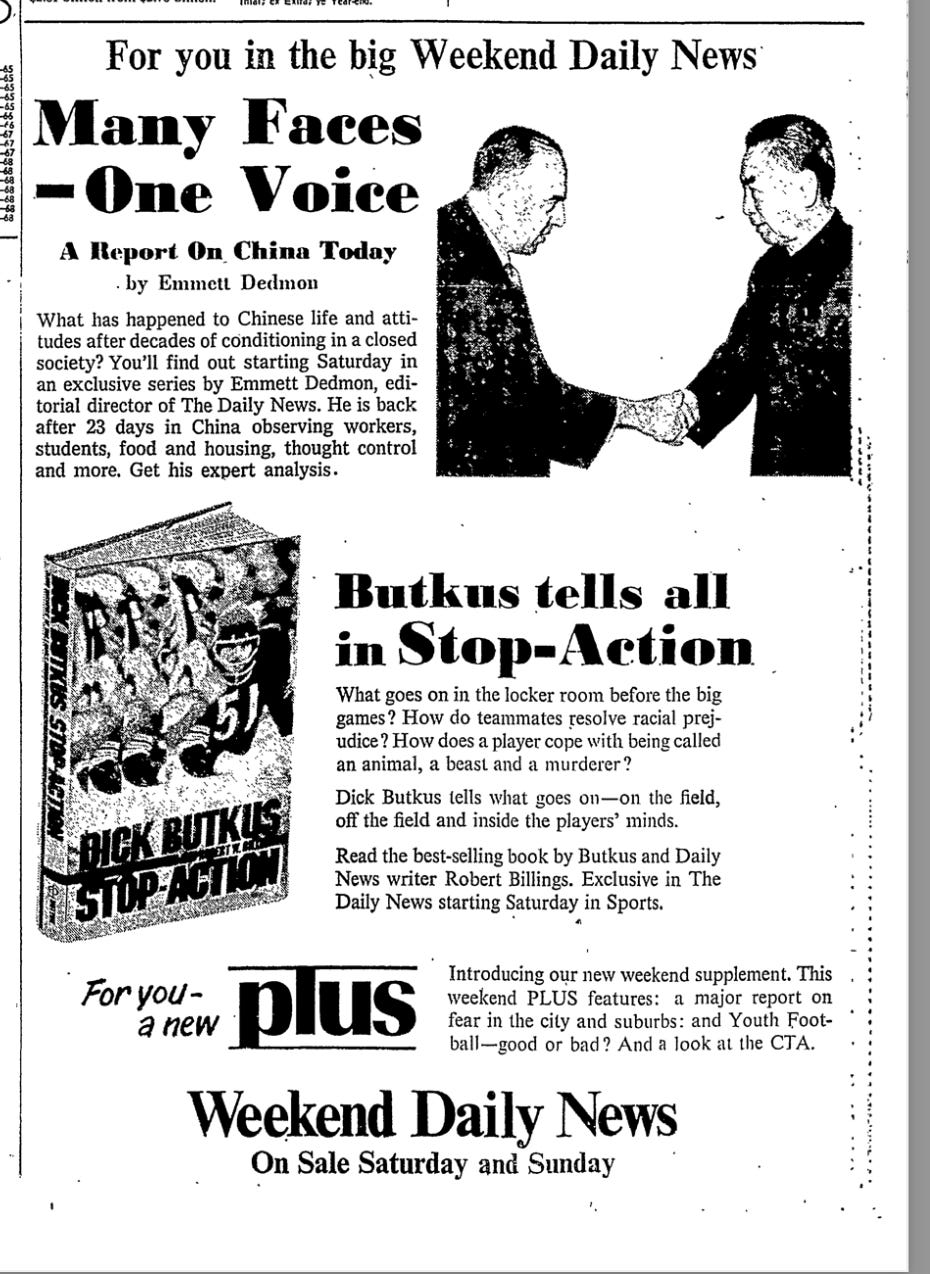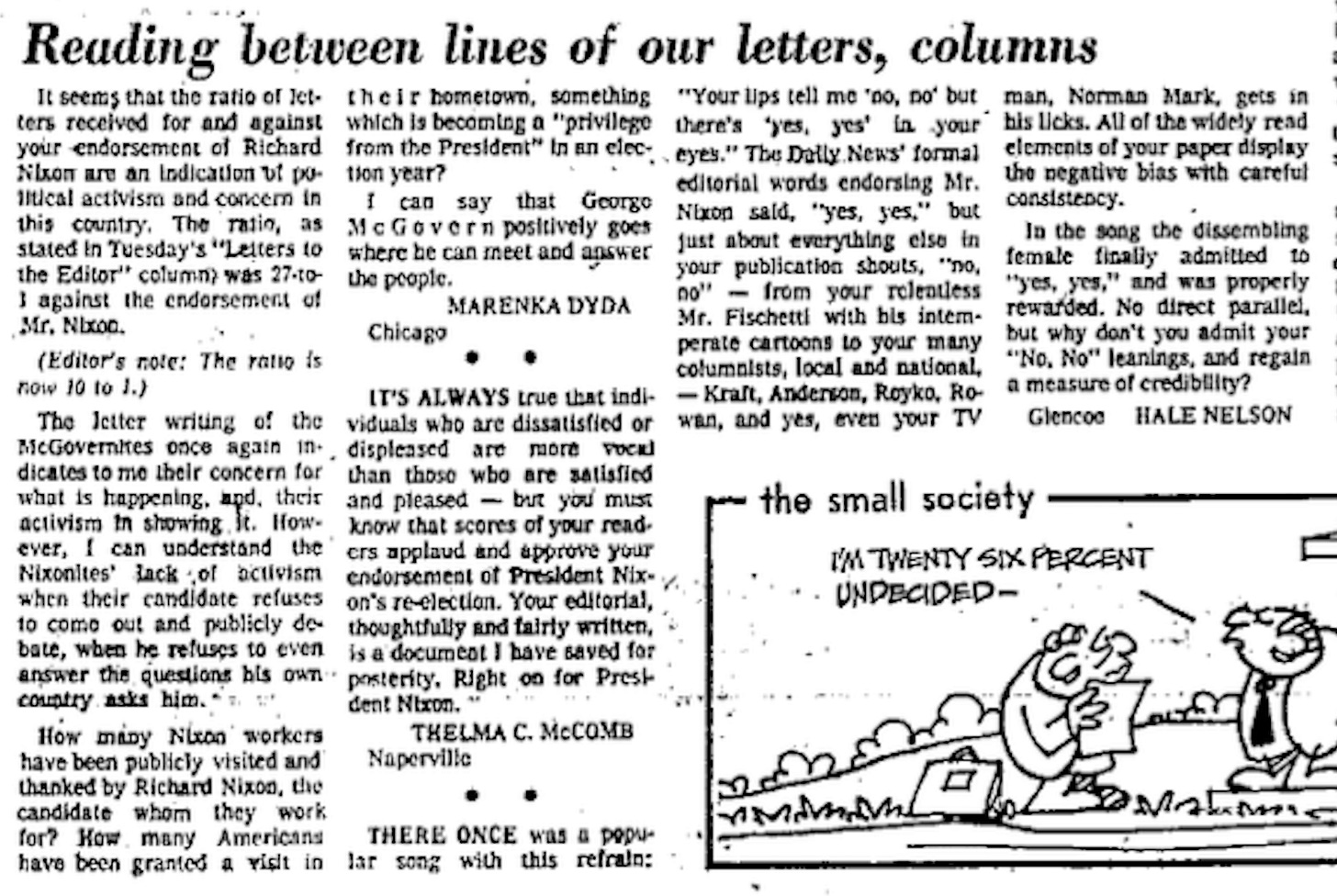THIS CRAZY DAY IN 1972: All we are say-ing, is "Give Kissinger a chance"
October 23-29, 1972
To access all website contents, click HERE.
Why do we run this separate item peeking into newspapers from 1972? Because 1972 is part of the ancient times when everybody read a paper. Everybody, everybody, everybody. Even kids. So Steve Bertolucci, the 10-year-old hero of the novel serialized at this Substack, read the paper too—sometimes just to have something to do. These are some of the stories he read. Follow THIS CRAZY DAY on Twitter: @RoselandChi1972.
MONDAY
October 23, 1972
Chicago Daily News: Magikist meets the Crosstown Expressway
Perhaps Bill Gage, founder of Chicago’s legendary Magikist cleaners, backed the controversial proposed Crosstown Expressway because he wanted another place to put up a fourth giant Magikist sign. That’s just a TCD72 theory. If so, boy was he sorry he got involved, as you’ll read in this item. Readers here know you don’t get much more controversial in 1972 than the Crosstown. How often do politicians threaten to punch priests?

For the latter half of 20th century Chicago, the Magikist lip signs towered over each of Chicago’s three expressways. The Magikist lips lit up the sky with red neon on every major route you could drive into the Loop. As the biggest landmarks outside downtown, the Magikist lips performed the job done elsewhere by mountains and rivers. Chicagoans used the Magikist lips to navigate the urban landscape, a neon North Star of sorts. Whether on the Kennedy, Dan Ryan or Eisenhower, the lips were about 80 feet wide. The small black rectangle below the lips gave the time, while the long black rectangle was an electronic sign that flashed changing messages to drivers.
The photo above shows the Magikist Lips from the Kennedy. Steve knew the Magikist lips at 85th on the Dan Ryan. Having never been west or north of the Loop, he had no idea the other Magikist signs even existed. BTW, we’ll dive into Magikist and the Dan Ryan in Chapter 8: Paul Siciliano.
Did you forget we’re serializing a book here? Sorry about that. TCD1972 and Mike Royko just became such all-consuming projects. I’ll resume posting chapters in January. At that point, we’ll have documented most truly key events of 1972 Chicago in the first round of TCD1972, and I’ll have all five Chicago dailies on microfilm, with articles clipped and filed by topic. Starting in 2023, weekly TCD1972 posts will either focus on specific 1972 topics, or cover the plethora of scandals, murders, and fascinating miscellany we skipped in 2022 due to space constraints. For Mike Royko, I’m thinking I’ll cover select 1973 columns, but probably not every single one. Time is limited.
Back to Magikist and the Crosstown:
no byline
“Motorists in rush-hour expressway traffic next week who see a flashing sign proclaiming, ‘We need the Crosstown Expressway’ may become confused,” the Daily News reports today in this article with no byline.
“Moments later, they will see another sign flash, ‘We don’t need the Crosstown Expressway.’”
“The contradictory messages on signs along the Kennedy, Eisenhower and Dan Ryan expressways will be on signs owned by Eye-Catcher Spectacular Signs, a subsidiary of Magikist Dry Cleaners.”
Bill Gage, per this article, agreed to run pro-Crosstown messages “as a public service for the Chicago Assn. of Commerce and Industry”.
And then he heard from the Anti-Crosstown Coalition.
“Gage was flooded with critical telephone calls.”
Regular readers will recall that the Crosstown Expressway is a massive project pushed by Mayor Daley, also known as “Daley’s Ditch” since it would have built below ground level. The Crosstown would pave over a mile-wide swath of neighborhoods between Kostner and Laramie, running in an L shape from the Kennedy-Edens junction to Midway Airport.
In 1972, the people who live in and around that footprint are not keen about the idea. The Crosstown would cost $1 billon—$6.75 billion in 2022 money. Seriously.
The leading group in the Anti-Crosstown Coalition is the Citizens Action Program (CAP), a group started through famed rabble rouser Saul Alinsky’s Industrial Areas Foundation with the original purpose of fighting Southwest Side pollution.
CAP’s leaders, including Father Leonard Dubi, learned well from Alinsky how to make themselves heard.
In late April, U.S. Rep. Roman Pucinski threatened to punch Father Dubi in the nose during a raucous Anti-Crosstown Coalition meeting outside Pucinski’s Milwaukee Avenue office. Pucinski was waffling on the issue.
Father Dubi asked Pucinski to reveal his family’s finances as Pucinski runs for U.S. Senator, prompting Pucinski’s fighting words:
“Say, if you weren’t a priest, I’d punch you right in the nose!”
“Go ahead! Go ahead!” yelled Father Dubi, but Pucinski backed down and retreated into his office. (For two profiles of Father Dubi, see here for Lois Wille’s piece in the Daily News, and here for Mary Leonard’s in Chicago Today. We’ll look more at Pucinski in the next round of TCD72.)
In advance of a June 25 rally in the Civic Center plaza, about 1,500 Crosstown protesters marched on 55th Street from Kostner to Laramie in 90-degree heat in May. That attracted politicians looking for votes, including Democratic gubernatorial wannabe Dan Walker and…Pucinski, who had figured out he should oppose the Crosstown for his U.S. Senate run against incumbent Republican Sen. Charles Percy.
After running into the Anti-Crosstown Coalition, Bill Gage also changed his mind.
So per this article, the Magikist signs will flash messages both for and against the Crosstown. Magikist apparently owns more flashing-message signs beyond the Lips, since the article stipulates that people will see the opposing messages “minutes apart.” The Magikist Lips by definition were quite far away from each other, each flanking a different expressway. In rush hour, it would probably have taken an hour to get from the 85th and Dan Ryan Lips to either of the other signs, and vise versa.
“I couldn’t care if they do or don’t build the expressway,” said Bill Gage. “I just wish they would either do it or not do it. You just can’t live in limbo.” The Magikist offices are in the path of the proposed Crosstown, at Cicero and the Eisenhower.
October 23, 1972
Chicago Today
Football betting is ubiquitous in 2022 with online gambling, but they didn’t just invent it. Who is David the Hungarian? I do not know.
Another odd thing: This ad says the Bears game is going to be covered by Jack Brickhouse and Kup! Or else they mean Brickhouse and Kup are going to talk to The Hungarian about his prediction. Either way…Kup?
“Kup did it too, yeah,” said Steve, completely unphased. “Kup did Bears games, no doubt.”
One feature I yearn to add to the site, though it will take a while, is a bio section for major Chicago 1972 figures. Then I won’t be surprised to find out the city’s leading gossip columnist announces NFL football games.
October 23, 1972
Chicago Sun-Times: Tom Fitzpatrick column
As the November 7 election barrels toward 1972 Chicago, all eyes follow Cook County State’s Attorney Edward Hanrahan— “The county prosecutor who has to campaign for re-election at night because by day he is a defendant in the Black Panther conspiracy trial,” as a Sun-Times article put it in a recent overview of Hanrahan’s race against Republican opponent Bernard Carey.
As regular TCD72 readers know, Hanrahan and 13 co-defendants are on trial for conspiracy to obstruct the investigation of the 1969 state’s attorney office’s police predawn raid on a Black Panther apartment, in which Panthers Fred Hampton and Mark Clark were killed.
What does that really mean though? It means they were accused of tampering with the evidence after the raid.
Here’s an Ed Hanrahan primer for anyone who’s just dropping in, or needs a refresher. If you’re good, skip ahead to the headline “And now, back to Fitz.”
Hanrahan Primer
Edward V. Hanrahan is 51 in 1972, and either headed to jail or the fifth floor of City Hall as a strong possible successor to Mayor Daley. Quite a divergent potential future.
The main thing about Hanrahan: He has a real temper on him.
Thumbnail background: Moved to Chicago as a child, lived in a West Side apartment only a few blocks from the Black Panther apartment his office would raid in 1969. After Our Lady of Sorrows and then St Philip High School, Hanrahan got an undergrad degree in accounting from Notre Dame, served in the U.S. Army Signal Corps in intelligence during World War II, and then graduated from Harvard law school.
Mayor Daley backed Hanrahan for a stint as U.S. Attorney for the Northern District in 1964, and then for Cook County State’s Attorney in 1968. So their political relationship is close indeed.
Legendary Tribune reporter Ron Grossman wrote one of his wonderful Chicago Flashback articles on the Panther raid, and gives this succinct context for the time period leading up to it:
“In the months leading up to the raid, Black Panther members were involved in two fiery gunbattles with Chicago police. The causes of the incidents were disputed, but in a July shootout, five police officers and three Black Panther members were wounded at the party's headquarters a block north of Hampton's apartment. In November, two police officers were killed and six were wounded in a South Side fight with Black Panther members, who themselves suffered one death and one injury. It was war, and a spy had infiltrated the Panthers' ranks. William O'Neal, a petty thief from the West Side, had driven a stolen car across state lines, a federal offense, and was offered a deal: Become an FBI informant and the case would go away.”
O’Neal’s FBI handlers asked him for a sketch of the Panther apartment showing the location of weapons. Then the FBI gave that information to Hanrahan’s office.
Why is the 1969 Panther raid trial only now under way, in 1972?
First, there were four separate investigations of the raid before Hanrahan et al were finally indicted by a special grand jury via special prosecutor Barnabas Sears. The indictments came down in June 1971, and then again in August 1971. Don’t even ask, it’s complicated.
The initial federal grand jury report blasted every level of the raid’s planning and execution, as well as the initial press coverage. As we’ve noted elsewhere, the Chicago Journalism Review, begun by local reporters disgusted with the coverage of the 1968 Democratic convention, devoted an entire issue to analyzing the Panther raid coverage. We’ll do a separate post excerpting some key points of that issue in the future.
Post-indictment, Hanrahan filed every conceivable motion to dismiss the charges. In May 1972, Bernard Carey held a fundraiser at the South Side’s Martinique and told reporters that Hanrahan “has been more successful than any person in history in avoiding trial….A double standard in justice is what he practices. He delays his own trial at the same time he decries delays in court on cases his staff is prosecuting.”

Hanrahan finally ran out of motions and chose a bench trial with Judge Philip Romiti, which started in July…and it’s still going as Halloween approaches.
“His courtroom experience consists principally of being a defendant,” Bernard Carey has noted.
We’ve covered some of the dramatic moments in Hanrahan’s trial, but we fell off in September and October. (See July 19, when Criminal Courts Building janitor Roy Tibbs told Hanrahan’s people they couldn’t use the special judge’s elevator, after they tried to get him kicked out of his seat in the first two rows of the courtroom. Hanrahan’s people said those rows were reserved for defense friends and family, but those two rows had only ever been used by Ed Hanrahan’s two brothers.) So many other crazy 1972 shenanigans to report! When we go ‘round 1972 again starting in January, we’ll fill in the Hanrahan trial gaps, because the minutia of the courtroom wrangling is worthwhile.
Meanwhile, Hanrahan is still a politician. Mayor Daley went ahead and put Hanrahan on the Democratic slate for re-election in the March 1972 primary, even though 100 Chicago groups including the Chicago Bar Association, the Better Government Association, and all the newspapers had asked Hanrahan to take a leave of absence after his indictment.
Mayor Daley said Hanrahan “made a good record,” adding, “If you disagree with me, then you disagree with the fundamental American system of law—that a man is presumed innocent until proven guilty.” This was quite a PR bomb among liberal voters, and Black voters in particular.
Rev. Jesse Jackson talked to Mayor Daley in his Sherman House Democratic Headquarters office the morning the slating committee met to decide on Hanrahan. Jackson hung around the headquarters all day to see the outcome. After Daley announced Hanrahan’s slating anyway, Jackson vowed he’d devote himself full-time to heading a citizen’s committee to defeat Hanrahan.
See Mike Royko’s December 8 column for the scene outside Daley’s Sherman House office that day, and see Tom Fitzpatrick’s December 7 column on how filmmaker Mike Gray hung around Sherman House all day trying to show his documentary, “The Murder of Fred Hampton,” to slating committee members.
“No political decision by the high command of the Democratic party in our memory has stirred more bitterness and resentment in the black community than the reslating of Hanrahan,” wrote the Defender in an editorial the next day.
But at 11 a.m. on December 20, the very day nominating petitions for the primary were due in the County Clerk’s office by 5 p.m., Mayor Daley announced he was dumping Hanrahan and putting Traffic Court Judge Raymond Berg on the Democratic ballot instead. Mike Royko’s column the next day broke the story of the Machine’s frenzied six hours forging 20,000 voter signatures on Ray Berg ballot petitions.
Why did Mayor Daley change his mind? Because Hanrahan had just lost an appeal to the Illinois Supreme Court to quash his charges, a case Hanrahan had called “unbeatable.”
Oh what a primary season as the spurned Hanrahan ran as an independent, indictment and all! Mayor Daley told reporters it proved how great the Democratic Party was.
The Cook County Electoral Board never kicked Ray Berg off the ballot, despite several separate investigations of the rampant and obvious petition signature forgeries. It was a three-way race between Hanrahan, regular Democrat Ray Berg, and independent Democrat Donald Page Moore.
Hanrahan debated Donald Page Moore in February, though Berg wouldn’t participate. At one point, Hanrahan asked the audience to be judged on his record. “We’re judging you,” yelled a Black audience member. “Fred Hampton. Mark Clark.”
“Hanrahan angrily took the microphone and declared: ‘For which I do not apologize to anyone,’” wrote the Sun-Times’ Paul McGrath.
Hanrahan stalked out as the audience erupted in jeers.
But the Democratic Machine’s precinct captains loved Hanrahan. At one lunch rally for the captains, Hanrahan had his campaign buttons smuggled onto the tables. At another luncheon, the captains opened fortune cookies and found messages reading, “Hanrahan’s the man.”
At the St. Patrick’s Day Parade, Hanrahan marched up to Mayor Daley sitting on the reviewing stand—
—doffed a top hat, pulled a false bottom out of the hat, and a white dove fluttered to the pavement, too dazed to fly.
Just before the primary date, Mayor Daley met with reporters in his fifth floor office and predicted Hanrahan “would not carry a single Chicago ward Tuesday in the three-way Democratic primary race”.
Instead, Hanrahan won, along with Mayor Daley’s enemy Dan Walker, who was running for the gubernatorial nomination.
And that was despite this great prank billboard, engineered by the Donald Page Moore team.
That’s a scoop I got 50 years later from Moore’s campaign manager, Chicago political legend Don Rose. See “Don Rose, Mike Royko, and the nutty 1972 primary” for more.

See Mike Royko’s March 22 column, “Hanrahan’s Revenge,” for a look at Hanrahan’s campaign headquarters on primary night. Hanrahan’s brother came up with the fortune cookie prank, Mike learned.
The main election campaign has been comparatively boring, now that Mayor Daley is exhorting the Machine soldiers to back the straight Democratic ticket, which includes Hanrahan. Mayor Daley has reconciled with Democratic presidential nominee U.S. Sen. George McGovern, despite the fact that McGovern let the Democratic National Convention toss Mayor Daley and his elected Cook County delegates out of the Miami convention hall in favor of a delegate slate headed by Ald. Bill Singer and Rev. Jesse Jackson.

One theory about Mayor Daley’s renewed relations with McGovern is that Mayor Daley is happy to endorse the straight Democratic ticket now, since it would mean getting Hanrahan re-elected—and not Republican Bernard Carey. We can confidently add that Mayor Daley didn’t get where he was by being stupid enough to cut off his nose to spite his face.
Every single newspaper has endorsed Bernard Carey to replace Ed Hanrahan on November 7.
The Chicago Bar Association’s Candidates Committee found Bernard Carey “qualified” and Hanrahan “unqualified,” because he’s “lacking in the temperament requisite to the position and is lacking judgment when under stress.” The Chicago Bar Association formally endorsed Carey a week later. It was a fun race, and we’ll fill in more of its coverage in 2023.
And now, back to Fitz
Fitz attends Ald. Seymour Simon’s 40th Ward election rally to rev up Machine precinct captains, who “sat on the edges of their folding chairs and nodded agreement at every sentence Simon uttered.”
The walls and ceiling in the unidentified hall are plastered with posters for all the Democratic candidates, balloons dangling everywhere. TV crews film for the various news shows in town, but pack up and leave after Secretary of State candidate Mike Howlett finishes his speech. Several speakers later, the crowd is happily following a bellowing, gesticulating congressional candidate Frank Annunzio— when heads begin to turn and whispering breaks out.
The crowd has spotted a limousine pulling up in front of the open doors, and Ed Hanrahan stepping out.
“‘It’s Hanrahan,’ they kept saying. ‘Hanrahan’s here. He made it.’
“Hanrahan walked into the hall, actually trying to be inconspicuous. He took a seat at the rear of the platform.”
I’m surprised at the rousing introduction Seymour Simon next gives Hanrahan. Sen. Adlai Stevenson, for instance, refused to endorse Hanrahan as long as he’s under indictment, a wishy-washy stance, but still.
“Every campaign needs a spark plug,” Simon exhorts the crowd, “a man who lifts and inspires every other candidate on the ticket, who keeps exciting audiences. He’s an old friend and an excellent lawyer whose legal ability is outstanding.”
That explains it. Simon and Hanrahan were personal friends.
Hanrahan gets a standing ovation, he’s smiling and happy.
“Right from the start you could detect the signals that this was not going to be a typical Hanrahan performance,” notes Fitz. The other reporters, photographers and cameramen had already left, for one thing, so— “There was no one for him to bait.”
Hanrahan urges everyone to work for a straight Democratic ticket, despite the crazy primary and the calamitous Democratic National Convention. The precinct captains are still plenty sore at George McGovern, after working their butts off to elect Mayor Daley’s slate of convention delegates.
“Why, suddenly, would we want to vote for a man that we wouldn’t even buy a used car from in 1960 or 1968?” Hanrahan asks. “They’re talking about him now like a saint. And just so no one has any doubt who I’m talking about, his name is Richard Nixon.”
“Let’s not forget what he did to Harry Truman and Dean Acheson. Let’s not forget about the China lobby. How he was the man who persuaded everyone it was evil to have anything to do with the Chinese. Let’s not forget that he went and made a deal with them during a political year.”
Hanrahan finally moved on to himself, “perhaps alluding” to his ongoing trial:
“No one who has ever stood with Ed Hanrahan has to worry about apologizing for his conduct.”
Applause.
“If I didn't feel I could come before you with a clear conscience, I wouldn’t have the gall to face you.”
“They stood up to applaud this time,” Fitz relates, “and Hanrahan broke into a broad grin. He held up his hands for silence.
“‘Let me say one more thing,’ he said. ‘I’m not spending one penny in any of the four papers in this town for advertising. You know what I’m going to do with that money?’”
Note Hanrahan ignores the existence of the Defender. When he says “four papers,” he means the Tribune, Daily News, Sun-Times and Chicago Today.
“I’m keeping it and after Election Day I’m going to throw the biggest party for Democratic precinct captains that this town has ever seen.
“And all you’ll need to get in is a ticket from Seymour Simon showing that you carried your ward for the Democratic ticket.”
October 23, 1972: De Mau Mau Week 2
Last week, Chicago was hit with a weeklong blitz of horrifying headlines about an alleged terrorist group of Black Vietnam veterans bent on randomly killing white people, possibly numbering up to 3,000 members nationwide.
For a full rundown, see the introduction to Mike Royko’s October 16 column on the topic or scroll through last week’s TCD1972, reading the daily coverage under the De Mau Mau heading. For a recap of the original horrifying crimes involved, see here.
The sensational coverage quickly drew criticism from Black leaders. The papers were pulling back on De Mau Mau coverage by the end of the week, with nearly all the weekend coverage consisting of stories about the criticism, not the story itself. This week, it’s like the story fell off a cliff. It certainly fell off the front pages, as we’ll see when the first news stories this week come on Wednesday.
Chicago Today: editorial, op-ed page
“It hasn’t taken long for ‘De Mau Mau’ to become part of the language—a very unfortunate part,” writes Today’s editorial board. “In the week since it was announced that six men had been arrested in connection with nine murders, and that they and two others were suspected of being members of a black revolutionary organization called De Mau Mau, the phrase has become widely used and heavily loaded….it symbolizes, in fact, a great deal more than it means.”
Today acknowledges “it’s time to put on the brakes, to start sorting out fact from fearful assumptions.”
The paper acknowledges that all anyone really knows is that ten Black men are charged with nine murders, all white people. “It is a long jump from this thing to talking about a nationwide murder organization, 3,000 strong”.
Today considers “how the gap was bridged.” Answer: “The reports of a nationwide terrorist organization came from” Sheriff Richard Elrod, State’s Attorney Edward Hanrahan, “and other law enforcement officials associated with the case. Put together, their quotes made a horrifying picture.”
Now, both the men and “the scary reports” are on trial, Today concludes.
“If they prove substantially true, that’s one problem; if it develops that we’ve been too quick to believe a dramatic official story—well, that’s a mistake we don’t mean to make again.”
Chicago Daily Defender: p. 4
no byline
“Officials of the Southside Chicago branch of the NAACP have charged the local white press with being ‘totally criminal and irresponsible’ in their handling of news stories and editorials relating to the De Mau Mau case.”
“It frightens me that the press is setting a mood which it may not be able to rectify when it charges that these six men are in fact members of a gang called De Mau Mau and that they have been ‘choosing white victims at random and killing them for no comprehensible reason beyond race hatred,’” said executive secretary Andrew C. Barrett, apparently quoting from news stories.
Barrett and South Side NAACP president E. Winston Williams said the original six defendants still didn’t have court-appointed attorneys, so they were concerned about due process as well as seeing the men tried and convicted in the papers.
“The press in stories and editorials has connected the six with other crimes as definite statements of fact, as if by some Divine eye, they have knowledge,” said Williams.
“We are finding as much fault with the irrational statements of Sheriff Elrod and State’s Attorney Hanrahan of Blacks roaming the countryside picking whites at random just as damaging,” said Barrett.
Chicago Daily News: Ellis Cose column, op-ed page
Ellis Cose is a Sun-Times reporter and columnist who’s Black, and would go on to a number of prestigious positions, including columnist and contributing editor at Newsweek for almost 20 years, and editorial page editor and editorial board chairman of the New York Daily News.
As of 2022, Cose has written a dozen books including “Democracy, If We Can Keep It,” which he describes as “the definitive history of the American Civil Liberties Union,” and his latest, “Race and Reckoning: From Founding Fathers to Today’s Disruptors.”
Today, Cose introduces his readers to a range of Vietnam veterans struggling to find work and fit in back home.
Joseph Garza wanted “to do something for my country,” and the best work he’s found so far is driving a cab 11 hours a day for about $70 net weekly profit, which is $472 in 2022 money.
Next: “A black veteran, 22, went into the Air Force because he wanted to learn a trade. He ended up with a nervous breakdown, a general discharge, and a great deal of bitterness toward a nation which refuses to give him a meaningful job. He said Vietnam had disoriented his mind, and added that he couldn't understand why a nation would train him to fight but not rehabilitate him and train him to become a functioning part of that nation.”
“His wife took his young son and left, he said, because he couldn’t find a job to support them. For a while, he said, he’d thought of suicide, but now he dwells on his growing resolve to do whatever is necessary to survive, be it legal or illegal.”
Job hunting is even harder for veterans with less than an honorable discharge. According to Barry Wright, head of Concerned Veterans From Vietnam, 40% of Black veterans didn’t get honorable discharges.
“Talk of black veteran terrorist groups abound,” Cose concludes. “Many veterans dismiss the concept as ridiculous but add that they can easily understand the sentiment for such a group. We welcome the returning soldiers with sympathy, give them the brushoff, and then pretend they will somehow melt into society….
“Many of these men feel that some cruel practical joke is unfolding at their expense, and they must wonder why nobody’s laughing.”
October 23, 1972
Chicago Tribune
Isn’t it interesting that Penthouse put this full page ad on the back page of the first section of the still quite Republican Tribune, of all places—and in no other paper in town?
What would the Colonel say?
October 23, 1972
Chicago Defender: Letter re Ed Hanrahan trial
Chicago Daily News
October 23, 1972: Continental’s Los Angeles Expressway
Continental continues its elaborate LA route promotions. Wait ‘til you see what’s coming.
Chicago Daily News
October 23, 1972: Illinois Democrats for Nixon
Chicago Defender
October 23, 1972: Stroh’s beer ad
Even Stroh’s is getting into the campaign spirit.
Chicago Daily News
October 23, 1972: Nixon and McGovern letters
Below, letter writer E.A. Sheehan refers to the fact that President Nixon wouldn’t debate his Democratic opponent, Sen. George McGovern. Nixon hasn’t been campaigning either, until this week—and the rally was disrupted by anti-war protestors. Instead of the president himself, everybody else in the Nixon family has been touring the country—wife Pat Nixon, daughters Julie and Tricia, and Ed Cox, Tricia’s husband.
See Mike Royko’s column Sept. 20 skewering campaigning Julie Nixon Eisenhower after she told reporters she was willing to die for the South Vietnamese government. Asked for comment, campaigning mother First Lady Pat Nixon said, “I certainly agree that I would be willing to die for 17 million people who now are aggressed against and having their freedom taken away.” Mike also took note in his Oct. 14 column when campaigning presidential son-in-law Ed Cox came to town and talked about how Americans need to have “great values” like a “work ethic.” Mike’s investigation found that 26-year-old recent law school grad Ed Cox had not yet had a real job.
I know this is a long set-up to a short letter, but this one really cracked me up.
Don’t miss Mike Royko 50 Years Ago Today
TUESDAY
October 24, 1972: The Mighty IC
Chicago Tribune
no byline
The Illinois Central Railroad, which runs the South Side commuter line serving Steve’s childhood and adult homes of Roseland and Hyde Park, has been crying all year that it lost $1 million in 1971 and expects to lose more in 1972, which got them a 7% rate increase from the Illinois Commerce Commission…
…despite an abysmal record for the past year in constant delays and shutdowns.
The IC has also been busy selling expensive air rights for the gigantic Illinois Center development just beginning on its rail yards covering the old Fort Dearborn site east of Michigan Avenue between Randolph and Wacker…
…and about 104 acres of more IC rail yards lining Roosevelt Road east of Michigan Avenue and extending all the way south to 31st Street.
But yesterday, parent company Illinois Central Industries announced third quarter net earnings “increased to $11.4 million, or 63 cents a share, from $10.2 million, or 57 cents a share, in the corresponding period of 1971.”
Also, the IC finished merging with Gulf, Mobile & Ohio Railroad on August 10.
October 24, 1972
Chicago Daily News: Mayor Daley loves a parade
That’s a political parade for Democratic vice-presidential candidate Sargent Shriver, who rode in a red convertible with wife Eunice and Mayor Daley.
“Only a few hecklers surfaced,” per the Daily News account by Charles Nicodemus. “One turned a thumb downward and yelled, ‘Not this time,’ while another cried at Shriver, ‘Get out and walk like Walker.’
“This was a reference to the publicized walk across Illinois made by Dan Walker, Democratic nominee for governor.”
Shriver later got a full standing ovation at a Democratic precinct captain’s lunch at the Sherman House hotel—where McGovern only got about half the captains on their feet during his recent swing through town, Nicodemus notes.
Shriver revved up the precinct captains by telling them that Republicans have launched “a big smear campaign” against McGovern. You may be surprised at what a Democrat sounded like in 1972:
“Republicans are going around the country saying McGovern favors abortion. That’s a lie.
“They’re saying George McGovern wants to put half the people on welfare. That’s a lie.
“They’re saying McGovern wants to grant amnesty to everybody—deserters, draft dodgers, queers and kooks. That’s another lie. Another smear.
“George McGovern is proposing nothing that hasn’t actually been done by every other President after other wars.”
October 24, 1972: De Mau Mau Week 2
Chicago Daily Defender: editorial, op-ed page
“It is a shocking paradox that at the precise moment when a certificate of merit was being awarded to an outstanding handicapped black veteran the event was punctuated by the news that eight alleged members of the Mau Mau gang had been captured for questioning in nine execution-style slayings,” writes the Defender editorial board, referring to Mayor Daley awarding a city “certificate of merit” to city draftsman David R. Wells, a disabled Black Vietnam veteran, during the initial De Mau Mau uproar.
Then, Sheriff Richard Elrod and State’s Attorney Edward Hanrahan held a dramatic press conference, announcing the suspects were also members of “an anti-white underground organization of national scope.”
“There was not a shred of evidence to support the contention that the Mau Maus were an incorporation of murderers sworn to wipe out innocent white people selected at random…..
“It was a deliberate, contemptible attempt to generate a white backlash against black veterans and the black population in the hope that this would in due course affect public sentiment in the unfinished Panther trial….
“We are not defending the captured Mau Maus. If they are really guilty of the series of criminal orgies ascribed to them, let the law take its course. But don’t smear all black Vietnam veterans and infuse white America with more hatred against blacks.”
October 24, 1972
Chicago Sun-Times: Republicans for McGovern ad
October 24, 1972: Bernard Carey Watch
Chicago Daily Defender
Bernard Carey’s dad writes the most adorable letter to the Defender.
October 24, 1972
Chicago Daily News: Letters on Nixon endorsement
Spoiler alert: All four major dailies endorsed Nixon for re-election. Strangely, I can’t find a Defender endorsement editorial, no matter how I search in the digital database for an editorial in case I somehow didn’t see it while browsing the issues. But if there was a Defender endorsement, it couldn’t have been for Nixon.
Daily News readers aren’t happy with their paper’s stand.
October 24, 1972: Hanramania
Chicago Daily News: Editorial
Straw polls show an incredibly tight race between Bernard Carey and State’s Attorney Ed Hanrahan—“but they also show an unusual pattern,” notes the Daily News editorial board.
“Hanrahan, the Democrat, is strong in normally Republican suburbs. Carey, the Republican, is strong in the normally Democratic inner city.”
This makes sense in the city, where Black voters detest Hanrahan, on trial now for conspiracy to obstruct the investigation into his office’s 1969 predawn police raid that killed Black Panthers Fred Hampton and Mark Clark. Rev. Jesse Jackson and other Black leaders are working hard to get Black voters to split their ballots and vote for Republican Bernard Carey in the State’s Attorney race.
But what’s up with the suburbs?
“Though he has zealously promoted a ‘law-and-order’ image, there is little evidence [Hanrahan] has acted in the best interests of suburbanites,” writes the Daily News.
The News gives a great example: The massive Machine vote fraud charges after every election, where the results of course favor Democrats, come at the expense of Republican suburbanites for county and state offices. The only time Hanrahan has gone after that vote fraud—as everyone has noticed for months, including the Daily News today—is when Hanrahan feared vote fraud in this year’s March primary, which might have hurt his own chances running as an independent Democrat after Mayor Daley threw him off the Machine candidate slate.
“Now that he’s palsy-walsy with the machine again, no repetition of that zeal can be expected,” notes the News.
In contrast, Bernard Carey is “a top-notch candidate” who would check “funny business at the polls,” and Carey’s law enforcement background including as an FBI agent makes him “eminently qualified”.
The Daily News advises Republican suburbanites to vote for Carey, if only over vote fraud.
“On this issue alone, Carey is the logical choice, for he means it when he says, ‘If they’re going to steal, they’d better steal enough to beat me, because I’ll prosecute them if I’m elected.’”
Farther on today, legendary Fifth Ward independent Ald. Leon Despres has his own theory about the Republican support for Hanrahan.
Chicago Sun-Times
Hanrahan goofs freed five felony suspects - Carey
by Joel Havemann
Bernard Carey charges that in a random check of 100 indicted suspects who were freed before trial, his staff found 18 who got out because Hanrahan’s office “blundered.”
Three suspects got out pre-trial because the State’s Attorney didn’t try to take them to court within the 120-day legal deadline. One got out because he didn’t get a preliminary hearing. For another, the evidence was thrown out due to a defective search warrant. Those five cases included murder, rape, and armed robbery.
“No wonder we are scared to death of the violence on the streets and the threats to the security of our homes. We have good reason to be,” Carey told reporters.
WEDNESDAY
October 25, 1972
Chicago Daily News: Merrill Chase Galleries
We’ll delve into the interesting history of Merrill Chase galleries on a slower week—but this is the first ad I’ve noticed, and I couldn’t resist.
October 25, 1972
Chicago Today: George McGovern ad
October 25, 1972
Chicago Today: Letters
Just a nice assortment here today. Daniel Sobieski, a frequent writer, tells a great story about the McGovern campaign; Bill Nigut complains about Chicago Today’s Nixon endorsement; and David Gaida writes about Italian-Americans and the Mafia.
October 25, 1972
Chicago Daily News: Veterans for Peace endorse Nixon
October 25, 1972
Chicago Today
by James Pearre
“Chicago will be torn by guerrilla warfare unless blacks and other minority groups are integrated rapidly into white society, Philip M. Hauser warned today.
“The outspoken University of Chicago sociologist and population expert told civic leaders here that metropolitan areas are facing an era of escalating, violent civil disorder.”
Hauser said Chicago and other cities could soon resemble 1972 Belfast, during a conference of the Chicago Association of Commerce at the Pick-Congress Hotel.
A little context from outside this article: Hauser went to the University of Chicago before spending about a decade with the United States Census Bureau. When he came back to Chicago as a sociology professor, he founded the Population Research Center, which he directed for over 30 years. Per his obituary in the University of Chicago Chronicle, Hauser studied urban segregation issues for decades and served on several advisory panels attempting to solve Chicago’s segregation issues.
“In 1963, he became chairman of the Advisory Panel for the Desegregation of the Chicago Public Schools,” writes the Chronicle. “The Board of Education accepted but did not act on the report, which called for the clustering of high schools so that students could choose which to attend….In the early 1980s, he assembled a team of experts to study the remap of city wards. Using the 1980 U.S. Census of Chicago, Hauser testified in U.S. District Court that the map had diluted the voting strengths of minority groups, especially African Americans and Hispanics.”
Back to Hauser at the Pick-Congress:
Hauser said Chicago was part of a global trend he called “population displosion,” a situation found in areas with “diverse racial, ethnic and religious groups.” Before, minority groups were simply subjugated, “thus averting conflict.”
“But today for the first time in human history virtually every minority group in the world is insisting on equality of opportunity, leading to bitter friction,” said Hauser.
Per Professor Hauser, Chicago was already seeing “guerrilla warfare” tactics by minority groups. “I’ve been appalled by the increase in recent years in the murder of policemen as symbols of the establishment and by the increase in bombings and civil disorders,” he told the conference.
Hauser criticized Mayor Daley’s CHA for dragging its feet on building public housing in white neighborhoods, and he criticized President Nixon for opposing busing students to integrate schools.
“If the United States remains more interested in keeping taxes down than in spending what is necessary to assure equality for minorities, we may in effect be saying we cannot afford to keep the United States a viable society.”
Talk about a cheap gift—it’s FREE!
October 25, 1972
Chicago Defender: Angela Davis ad
October 25, 1972
Chicago Today: Chicago Line
Have you won the 1972 office pool yet?
October 25-26, 1972: Acquitted
After 1,056 days, 39 prosecution witnesses, and over $1 million in tax dollars ($7 million in 2022), Judge Philip Romiti has ruled.
The defense attorneys for State’s Attorney Ed Hanrahan and 13 co-defendants asked for a directed verdict as soon as special prosecutor Barnabas Sears rested his case on October 11. They got it.
I’d start with Mike Royko’s October 26 column on the trial outcome, but he gets his own post—don’t miss it: “Mike Royko 50 Years Ago Today: Close Encounters of the Hanrahan Kind.”
October 26, 1972
Chicago Tribune
Hanrahan and his 13 co-defendants were found innocent, writes the Trib’s Jerry Crimmins, “In a ruling which took three minutes to read” by Judge Philip Romiti, who said he tried to consider the evidence “in a light most favorable to the prosecution.”
Recall that the defendants were charged with conspiracy to obstruct the investigation into Hanrahan’s office’s predawn police raid on a West Side Black Panther apartment in 1969, in which Panthers Fred Hampton and Mark Clark were killed.
“This court can only conclude and does conclude that the evidence is simply not sufficient to establish or prove any conspiracy against any defendant,” Romiti read/said, because “the prosecution has simply failed to prove the conspiracies…as charged in this indictment.”
The case, said Romiti, was “replete with speculation and conjecture. The court found it necessary to engage in an evidentiary striptease, so to speak—to strip away the layers of rhetoric and oratory, the emotional appeals, the speculation and conjecture—in its search for some basic hard evidence tending to prove the charges in the indictment. The evidence was insufficient.”
Before Romiti read his ruling, writes Crimmins, the Hanrahan supporters packing the courtroom “appeared light-hearted…But beneath the light-heartedness traces of fear and apprehension could be detected—especially from relatives of the defendants.”
As Judge Romiti spoke, “People who were holding their breath before the decision was read breathed audible sighs of relief as he finished. Then, as Judge Romiti’s last few syllables still hung in the air most of the 150 people in the courtroom began applauding and cheering. Many grabbed their neighbor’s hands in congratulatory handshakes. Several women and some men wept, dabbing tears from their eyes.
“Special prosecutor Barnabas F. Sears and his two black assistants, Howard Savage and Ellis Reid, looked strangely out of place in the wild courtroom as they sat silent and unmoving at their table.”
After all the celebrating in the courtroom, Hanrahan and the press moved to the second-floor State’s Attorney office for a press conference, writes Crimmins. Hanrahan read his own statement in “the tiny room, which was packed with television lights and cameras”:
“Right from the start I said there was no basis for this indictment…the trial has proved just that…if the objective grand jury investigation ordered by Judge Power had been made, including an investigation of the Black Panthers, the facts revealed at the trial would have been learned and there would never have been an indictment in the first place.”
October 26, 1972
Chicago Sun-Times
by Art Petacque and Kingsley Wood
Other points brought out in this account:
In his ruling, “Judge Romiti said that in view of the great mass of ‘frequently conflicting, sometimes confusing testimony’ offered during the trial, ‘it is easy to lose sight of the real issue. It is not the issue before this court to determine precisely who fired which weapon, how many times and from what physical part of the apartment. The gut and only issue is whether there was a conspiracy by the defendants,” which the prosecution “has simply failed to prove”.
Also from Judge Romiti: “This court is aware, painfully so, that this is one of those ‘you’re damned if you do and damned if you don’t’ cases. The only question is which way one is going to be damned.”
From Hanrahan: “The police certainly did not deserve the abuse and anguish they and their families have endured for almost three years. Rather, the courage of the police in doing their duty in the face off the Black Panthers’ armed resistance deserves the praise and thanks of every law-abiding citizen.”
Special prosecutor Barnabas F. Sears—who, let’s remember, successfully prosecuted the infamous Summerdale police scandal case—“apparently was ready for the adverse verdict.
“He handed newsmen a printed statement that said, ‘The court has spoken. It is my duty as a lawyer participant in the case to treat that judgement of the court with respect. This I do.
“Respect for the law and the maintenance of the judicial system so essential to our survival as a free society alike demands that I do this. I have no further comment.”
Sears added that he’s going on a several week vacation.
October 26, 1972
Chicago Tribune
by Ridgely Hunt
Despite the headline, Ridgley Hunt’s assignment was covering the reporters covering the trial. As Judge Romiti read his ruling, the press as always sat together on the righthand side of the courtroom, he writes—about 30 reporters and six courtroom artists.
“For several minutes [Judge Romiti] read while the artists sketched and the reporters filled page after page in their notebooks.”
As Judge Romiti finished and the cheers broke out, “Hectic activity from the newsmen on the right. Some leaped to their feet and bolted for the door in the rear of the room. Some leaped to their feet and pushed toward the front, where a low barrier halted their advance.”
Special prosecutor Barnabas Sears was on the other side— “surrounded by humanity but isolated in defeat. An old man and tired, he peered thru steel-rimmed spectacles at the faces of the carnivorous press. Then he distributed a printed statement…
“‘You seem to have been expecting this, Mr. Sears,’ a newsman shouted into the old man’s face. Sears answered him nothing, but turned and walked away.”
The Hanrahan press conference afterward took place “in a sheriff’s police squad room,” writes Hunt. “It wasn’t much of a room for a press conference—100 newsmen crammed in where there wasn’t room for 25, everyone standing on tables and chairs to get a better view, and, right up in front, six television cameramen with six television cameras mounted on their shoulders like turrets on tanks.”
October 25, 1972
Chicago Daily News
by Phil Blake
This overview describes the start of the case in the aftermath of the 1969 state’s attorney office’s predawn police raid that killed Fred Hampton and Mark Clark:
“For nearly two weeks after the raid the apartment at 2337 W. Monroe remained open and thousands of people walked through it and viewed its bullet-ridden walls at the ‘open house’ invitation of the Panthers.”
[Note: A Sun-Times account reports that Cook County Coroner Andrew Toman didn’t seal the crime scene until Dec. 17, 13 days after the raid.]
“Initial investigations of the raid by the police internal affairs division and by a Cook County coroner’s jury were completed later. Neither investigation suggested anything improper in the conduct of the raid.
“Within a week after the raid, State’s Atty. Edward V. Hanrahan had publicized his version of the raid in an exclusive account given to the Chicago Tribune and in a filmed re-enactment shown on WBBM-TV (Channel 2).
“The Tribune story was accompanied by photographs purportedly of bullet holes caused by Panther guns, but that later were shown to be nailheads by other Chicago newspapers. The accounts also contrasted markedly with much of the physical evidence in the case.”
Ultimately, a special federal grand jury “empaneled to determine if there were civil rights violations” during the raid released a report which “was harshly critical of everyone who was party to the raid….The report, which termed the raid ‘ill-conceived,’ was critical of nearly everything involved—from the police investigation of the raid to the refusal by the Panthers who survived to testify before the federal grand jury and the press coverage after the raid.”
What about the biggest question: Why did Romiti find no evidence for a conspiracy?
For that, we’ll draw both from Phil Blake’s Daily News account, and the Sun-Times report by Art Petacque and Kingsley Wood. There were two major turning points cited by all the papers.
#1: New witness statements
All accounts agree that the single most damaging development to the prosecution came early on, when prosecutor Barnabas Sears himself came forward with statements allegedly made by the surviving Panthers immediately after the raid, to their own lawyers.
Sun-Times: “The defense immediately charged that if the statements were true, the Panthers lied in their grand jury testimony when they denied firing shots [at the police] and handling guns during the raid.
“The statements raised the possibility that as many as four shots, rather than merely one, could have been fired by the Panthers.”
Judge Romiti paused the trial for a hearing to determine the authenticity of the statements, but that “was never clearly established…because the lawyers who originally represented the Panther survivors refused to testify about details in the statements. They claimed the lawyer-client relationship precluded such testimony.” (Covered here July 25, July 27 here and here, July 28 here, here, and here in Fitz’s column, and July 29. The only real outcome was no outcome—the affidavits weren’t verified, but the trial didn’t end, announced on Aug. 7 and Aug. 8.)
Then came testimony from some of the raid survivors. One survivor, Brenda Harris, “admitted under cross-examination that she lied when she told three of the special prosecutors that she did not see any Panther guns in the apartment at the time of the raid.”
#2: Chicago Police Supt. James Conlisk’s testimony
Daily News: “Conlisk admitted that he had told the grand jury that the police investigation of the raid was incomplete, but testified that he changed his mind in the four days before he took the witness stand.
“Conlisk told Romiti he believed the investigation was ‘complete’ and refused to budge during 70 minutes of questioning by Sears. Afterward, Sears told Romiti he was ‘completely taken by surprise’ by testimony from Conlisk, whom he had called as a prosecution witness.”
Chicago Daily News: Carey response
Republican State’s Attorney candidate Bernard Carey tells reporters that the acquittal doesn’t vindicate Hanrahan, because it doesn’t change anything about the 1969 predawn raid on the West Side Black Panther apartment that killed Fred Hampton and Mark Clark:
“The manner in which the raid was planned and conducted violated every rule of professional law enforcement. That is a fact, unchanged by the verdict.”
“The trial had started on July 11,” Fitz begins today. “For Judge Philip Romiti it had been a grueling test of both his intellectual and physical capacities.
“Each day it had been the same. A long session in court and then hours more at his home in Hillside studying the transcripts of the trial and his own written record.”
Romiti finished typing his ruling at 3:30 a.m. Wednesday morning, went to bed, got up at 6:30 a.m. and by 8:30 he was back in his courtroom in the Criminal Courts Building at 26th and California.
Fitz writes that Romiti wasn’t ready for the “outburst of applause and cheering” as he finished reading his statement.
“Tears came to the eyes of several of the policemen who had been defendants in the case. State’s Atty. Edward V. Hanrahan, sitting underneath a window to the right of Jude Romiti, remained expressionless but his brother Bill leaped to his feet and began cheering.”
Note: Incredibly, as far as I can see, Fitz’s is the only account that describes Hanrahan’s reaction when Judge Romiti read his ruling.
…. “Even the bailiffs were cheering and shaking hands with the defendants. It was like a locker room of the winning team in the World Series. The only thing missing was popping champagne bottles.”
“Judge Romiti walked off the bench almost unnoticed…Once in his chambers, Judge Romiti removed his black robe and sat down in the thick, high-backed leather chair behind his desk.”
Romiti won’t comment further on the case, he tells Fitz. Maybe in six months or so, but he doesn’t think it would be proper. But then he comments anyway:
“One thing, there was so much publicity surrounding it because of the people involved and the climate of the times. That was one important element. I had to keep reminding myself: ‘Are these men to be penalized in this matter merely because of who they are and because of the climate of the times?’”
A lot of people thought Romiti wouldn’t acquit because of the controversy sure to follow, Fitz notes.
“I thought about that,” Romiti tells him. “But I’ve got to have the guts to rule. If I don’t have the guts then I shouldn’t be on the bench. That’s a judge’s job.”
Fitz sees elated defense attorney John Coghlan leave the building “with his wife on his arm, headed for a victory luncheon.”
Coghlan thinks the case was won during the questioning of FBI agent Robert Zimmer, the authority who determined that out of almost 100 shots, the Panthers had fired only one.
“He had the integrity to change his mind and admit that shots might have been fired after all without lodging in the wall of the apartment,” Coghlan tells Fitz. “I asked him that question five times. Then I showed him the diagram of the apartment again. I made him study it again. Then on the sixth time he came over to our side. He was the last witness in the case. When he changed his mind I knew we’d won. I walked by Ed Hanrahan on the way back to my chair and I said to him, ‘Ed, you’re home free. That one did it.’”
Note: Other accounts say Zimmerman didn't budge on this point.
As Coghlan leaves, the elevators doors open near Fitz.
“Bill Hampton, brother of Fred Hampton, one of two Black Panthers slain in the raid stepped out.
“‘What do you think of the verdict?’ a man asked.
“Bill Hampton smiled.
“‘I’m not surprised,’ he said. ‘It’s what I expected all along.’”
October 26, 1972
Chicago Today
by Jeff Lyon
Today’s Jeff Lyon covers Hanrahan post-acquittal—an assignment that started with “a solid Greek lunch in Diana’s Restaurant, 212 S. Halsted” with his 13 co-defendants and their lawyers.
Dianna’s! The legendary Dianna’s, home of legendary Petros!

Older Readers, please add your Petros memories to the comments. Younger Readers, Petros was the ebullient, gregarious, sometimes out-of-his-mind owner of Dianna’s, who seemed to live there, and to live only to keep a party going in Dianna’s 24 hours a day. He was tall, lanky, with long black hair. Was there ever a Dianna’s patron who walked in and didn’t get kissed or clapped on the back by Petros before being seated? Anyone who ever ordered saganaki without the waiter reliably lighting it on fire, the flames shooting up to singe the garlands with tiny paper Greek flags that criss-crossed the dining room ceiling, as the entire restaurant shouted “Oopa!!” together in ecstasy, Petros’ voice rising above the rest? And Dianna’s never carded. If you were old enough to eat there, you were old enough to drink the Roditis wine. That’s why Steve went to Dianna’s after his junior and senior proms.
Today, Dianna’s is Athena, but at least it’s still a Greek restaurant. Sadly, Petros died in 1990, only 60 years old per his Tribune obituary: “Mr. Kogeones came to Chicago from southern Greece in 1955 and became a partner with his uncle at Diana Grocery. He added tables and eventually moved the restaurant to 130 S. Halsted St.” I don’t know why they spell “Diana’s” with one ‘n,’ since the restaurant’s sign used two.
Diana’s is where Ed Hanrahan spent his first hours after the specter of conviction was lifted from his head, and I wish I could have seen Petros.
“The repast was brief, but [Hanrahan] paused just inside for a picture-taking ceremony with a man in a white apron who appeared to be the proprietor.”
Petros! A glimpse of Petros!
“The large group was laughing heartily amidst pungent cheeses, spices and meats.”
Jeff Lyon actually opens his piece as Hanrahan parties in the early evening at Nielsen’s Restaurant, 7330 W. North Ave. in Elmwood Park, where he “delivered a tub-thumping political speech” at a party/rally.
“The State’s Attorney of Cook County was acting like the life of the Party as he tried to prod friends, newsmen and fellow Democrats into making a night of it,” writes Lyon.
“It’s the greatest day in the world for me,” he yelled….[T]o a reporter he confided, “Of course the adrenalin is pumping thru me. I’ve had the weight of three years lived off of me. A better way to put it,” he said, sipping from a highball glass, ‘is to compare it to a horse race.
“‘Take a good horse, but put a lot of weight on him and he struggles. Take that weight off, tho, and he runs a lot faster.’”
Hanrahan tried to convince friends at Nielsen’s to follow on his night of electioneering, “which would take him as far south as 179th and Halsted Streets. When several weary people declined, he smiled, held his glass aloft and said, ‘Why, it’s only halfway thru the night. The shank of the evening.”
This is all surreal, a veritable political Twilight Zone, because reporters typically see Hanrahan in one of two modes—mad, or acting mad the minute he sees reporters. Good example: The Sun-Times’ Tom Fitzpatrick described how Hanrahan arrived for a March press conference, “paused slightly at the door before entering, making sure the television lights were on,” then “wiped the smile off his face” and turned on a fulminating tirade against a newspaper story that ended with Hanrahan quoting first William Cullen Bryan’s “The Battle-Field” (Truth, crushed to earth, will rise again”) and then “Macbeth.”
Hanrahan hands off drinks as he leaves one party and gets in his chauffeured car to head to the next, so he was probably slightly in his cups by the time he got to the Friends of the Oak Park Regular Democratic Organization, and started talking to a crowd of 300 about himself.
“Some say you shouldn’t be temperamental,” Hanrahan said, probably alluding to the Chicago Bar Association’s negative assessment of him. “But when I see a case where a couple are fighting over the last cigaret in the pack and the woman kills the man in anger, how can I not be concerned?
“When a woman comes home at 11 p.m. from work and she is killed by an animal—an animal—and I don’t care what color the attacker is—how can I be unconcerned?
“I have temperament, yes. But my legal ability after 17 years of practicing law every day should not be questioned. I want to keep the West Side Irish neighborhood a safe, clean place, and the same goes for 47th and King Drive.”
October 26, 1972
Chicago Daily News: Hanrahan parties
Hanrahan really got around Wednesday night—here he is at Zum Deutschen Eck.
The Tribune wrote Zum Deutschen Eck’s obituary in 2000 as the restaurant closed after a nearly 50-year run.
The restaurant’s honorary street sign remains, but the building is replaced by a parking lot. The Chicago Bar Project has a whole page for Zum Deutschen Eck, whose name meant “The German Corner.” It was across from the Athenaeum.
October 25, 1972
Chicago Daily News
by Lu Palmer
“Bitter disappointment but no surprise was the reaction of several black leaders to the acquittal of State’s Atty. Edward V. Hanrahan and 13 others in the Black Panther conspiracy trial,” writes Lu Palmer.
Bobby Rush, in 2022 the outgoing long-time U.S. Representative and former alderman, wasn’t a politician yet in 1972. He was head of the Illinois Black Panther Party, having “inherited the leadership…after its chairman, Fred Hampton, and Mark Clark were killed in the Dec. 4, 1969 raid out of which the Hanrahan charges grew”.
“The Black Panther Party is at one with the black community in not being surprised that Hanrahan can murder without being punished,” Rush told Lu Palmer. “But we must remember that the great conspiracy was not just Hanrahan’s. It was a conspiracy by the whole federal, state and local government apparatus. The courts were used as an instrument to legitimize the murder of black people.”
“All Judge Philip Romiti did was to extend the right of institutions and law enforcement agencies to commit genocide on black people,” said local NAACP director Andrew Barrett. “We are disappointed but not surprised. I used to have some respect for Judge Romiti but now I have no respect for him at all.”
“U.S. Rep. Ralph H. Metcalfe (D-Ill) said Hanrahan’s acquittal ‘will not lessen my opposition to his re-election. His acquittal did not come as any surprise to me. The fact that he asked for a bench trial and refused to go before a jury of his peers was an indication that he would be acquitted.”
Metcalfe adds that he opposes Hanrahan “based on his very poor record” of getting convictions: “It is a fraud for Hanrahan to say he has broken up the gangs. Just last night there was a gang killing. It is a fraud for Hanrahan to say he has reduced crime when crime is up in Cook County and in Chicago.”
October 26, 1972
Chicago Sun-Times
by Harry Golden Jr.
“Mayor Daley cheered acquittal of State’s Atty. Edward V. Hanrahan Wednesday and said dumping him from the Democratic slate was ‘just a mistake,’” reports Harry Golden.
“It indicates again one of the things we must guard against—relying on charges made against people as though they were accurate and true,” said Daley. “After a thorough trial and after all the facts and evidence are brought out, it indicates something else. It should be a great lesson to all of us.”
“Asked if that lesson should be applied also to the De Mau Mau case, in which eight black men are accused of killing nine whites, Daley said, ‘It applies to anything. Too much do we rely on allegations, it is a sad commentary that a lot of people are hurt, hurt badly, without a chance to have their side heard.”
These quotes are obviously cleaned up, still typical outside Mike Royko columns.
The Daley-Hanrahan rift is not healed. Mayor Daley says he called Hanrahan to congratulate him, and Hanrahan just said “Thank you.”
Legendary independent 5th Ward Ald. Leon Despres has a different take:
“It is very timely. If it were arranged, it couldn’t be more favorable to Hanrahan. However, it doesn’t clear him with the people who read the account of the court proceedings.
“He may not be criminally liable, but the grave impropriety remains. It’s a very strange thing: what gives him the edge in the election is the widespread belief among bigots that he was really guilt.”
October 26, 1972: The Mighty IC
Chicago Tribune
no byline
The Illinois Central commuter line that serves the South Side and south suburbs—the IC—racked up 18 serious delays in the last four months of 1971 alone, then piled up at least five more equally bad shutdowns in the first two months of 1972. One day, there was a 30-train back up during morning rush hour, making at least 12,000 passengers late for work.
Top IC executives told the Tribune in an exclusive interview earlier this year that the whole problem is the nearly 50-year-old IC cars, which are being slowly replaced with new double-decker cars. But the executive also admitted that after they ordered the new replacement cars in 1969, they “decided that no major overhaul work or other major repairs would be made to the old commuter cars. Instead of spending money to rebuild the old cars for 10 to 15 more years of operation, the Illinois Central officials specified that the cars be kept running on a safe basis at a minimum of maintenance expense.”
And then they got a 7% fare increase approved by the Illinois Commerce Commission, claiming a $1 million loss for 1971.
Which brings us to today.
“A derailment near the Roosevelt Rd. station of the Illinois Central R.R. caused a major tie-up in the line’s commuter service Thursday, delaying commuters as much as 90 minutes,” report the Trib.
“Hundreds off commuters walked off trains that were backed up behind the derailment, streaming over tracks to the station or into Grant Park to catch busy or walk to their offices.”
This time, the IC doesn’t blame the shutdown on one of the old, antiquated cars about to go out of service. The problem is one of the shiny new double-decker cars, which derailed as it was going through a switch at 11th Place.

“It couldn’t have happened at a worse place,” said the IC spokesman, who said they think the problem was a faulty switch.
“Railroad officials attempted to back up some trains behind the derailed cars to 67th St. but passengers began jumping off the cars, some of them as the trains were moving.”
According to one IC passenger who fumed to the Tribune, “They sat us there for an hour in the yards without saying a thing, Not a word about a derailment, which we could understand. Finally some people forced open the door of a car, and passengers began flowing out…The conductor warned the engineer not to move the train but suddenly began moving while people were jumping off.”
October 25-26, 1972: De Mau Mau Week 2
The first news articles on the De Mau Mau case come on Wednesday in Week 2. The four major dailies play the story so quietly that none use the term “De Mau Mau” in headlines. The Sun-Times puts the story farthest forward, but it’s still on page 12. The Daily News puts it on p. 14, while Today and the Tribune shove it to pages 20 and 27 respectively. Only the Defender uses “De Mau Mau” in the headline. The Defender puts the story on page 4, but still doesn’t tout it on the front page. Also, since the Defender is a smaller paper, page 4 is the equivalent really of page 12 or 14 for the larger papers.
William “Butch” Jackson, 22, one of the De Mau Mau suspects, testified Tuesday at a preliminary hearing to determine whether there is enough evidence to send the case to a grand jury.
Jackson said he met the four defendants twice in August. The first time was Aug. 5, a few hours after the murders. “Ben Taylor told me that in Barrington Hills they had put some people in a pantry and offed them,” said Jackson. A week later, he said, Ben Taylor told him the dog was “making a lot of noise”. “He told me he threw a knife and cut the dog. A woman jumped up, grabbed the dog and started screaming. She was knocked down by Ben Taylor.” Donald Taylor, according to Jackson, said the dog “looked like a Polish sausage.”
The four defendants today are Reuben (Ben) Taylor, Donald Taylor, Nathaniel Burse and Michael Clark. They’re charged with killing the Corbett family in their Barrington Hills mansion in August.
Jackson “revealed the charges against him have been dropped,” writes the Sun-Times’ Kingsley Wood. Defense attorneys “tried to portray him as a man who was telling authorities what they wanted to know in return for his freedom. ‘You can walk out of the courtroom after you’ve testified right?’ asked defense attorney Richard A. Halprin.”
Only the Tribune notes that this means Jackson is apparently the informer who gave police the information necessary to arrest the other suspects originally.
Judge Maurice D. Pompey sustained the prosecution’s objection to that. Per the Daily News, “Lake County authorities said later they have a warrant for Jackson naming him as one of the alleged killings of William Richter,” the soldier who was killed while sleeping in his truck on the shoulder of the Edens Expressway in June.
Judge Pompey also denied defense motions to postpone the trial indefinitely or drop the charges due to the “excessive” pretrial publicity, and to investigate which public officials leaked information to reporters. Defense attorney Halprin wanted to investigate whether information was leaked to affect the November 7 election.
Only Chicago Today really refers to last week’s sensational stories with this brief summing up: “Jackson previously had been one of 10 young men arrested as part of a black terrorist group accused of wantonly killing white persons thruout the state.”
Chicago Today and the Defender focus in their headlines on Jackson making a mistake in his testimony. It’s unclear whether it means anything, or if it was just a misstatement. Jackson first testified that he was arrested on September 14 “with my woman” at the Michigan Inn Motel, 3536 S. Michigan. Jackson gave his current address as the Cook County witness quarters, and later, when prosecutor Thomas Fitzgerald asked how long he’d been there, Jackson said, “Since Oct. 14, two days after I was arrested.”
The hearing continues on Friday.

Chicago Defender: Letter re Dr. Charles G. Hurst
This letter refers to the first day of coverage of the De Mau Mau case, when Malcolm X College President Charles G. Hurst told reporters including the Defender that four of the suspects had been students at his school.
Hurst said the De Mau Mau suspects had threatened students on campus until they were expelled in spring 1972, and their elaborate ritual handshake was barred from campus. “It was pure terror,” the Defender quoted Hurst. “Members of the Mau Mau would intimidate and beat up students and teachers.” Hurst said he didn’t think the Mau Maus were political, and didn’t believe their alleged crimes were racial. “It was just plain hatred.”
A day later, Hurst held a press conference with Barry Wright, head of Concerned Veterans From Vietnam and denied there had any been any De Mau Mau presence on his campus. Hurst said the suspects had been expelled for bad grades and attendance.
Leo W. Burroughs, Jr. comments on Hurst’s comments:
THURSDAY
October 26, 1972
Chicago Daily News: Christmas Seals
Like Easter Seals, Christmas Seals used to be a big annual part of the holiday season. See TCD72 on Feb. 28 for Playboy bunnies posing with “a 7-year-old crippled boy” to promote Easter Seals this year. The poor kid just looks like he wants to go home.
Christmas Seals, to their credit, have merely created yet another reason to crown a woman for their publicity.
Christmas Seals don’t get the attention they used to, but they still exist. The American Lung Association runs the Christmas Seals campaign, which began in 1907 to end tuberculosis. “Today, they help us make progress toward defeating asthma, lung cancer, influenza, tobacco use, air pollution, and other lung diseases, including COVID-19,” per the official website.
October 26, 1972
Chicago Today: Report on Women in Politics promo
October 26, 1972
Chicago Daily News: Sear’s girdle ad
October 26, 1972
Chicago Daily News: Wieboldt’s girdle ad
October 26, 1972
Chicago Daily News: Women put on mustaches
October 26, 1972
Chicago Daily News: Kissinger
October 27, 1972
FRIDAY
October 27, 1972
Chicago Sun-Times: Goldblatt’s girdle ad
October 27, 1972
Chicago Daily News: Statuemakers ad
October 27, 1972
Chicago Daily News: Herguth’s People
October 27, 1972
Chicago Today
Well, that didn’t last long.
October 27, 1972
Chicago Daily News: Wolk Camera ad
October 27, 1972
Chicago Tribune: Vernon Jarrett column
“‘Just look at that,’ the man said, pointing to the big headline on the front page of Chicago Today. ‘Shocking, isn’t it?’”
“‘Naw, brother, it don’t shock me,’ his companion answered. ‘I expected it. I knew it was going to turn out like that. The man, you know—’the man’—can do anything he wants to ‘cause we been doing all that talking but ain’t done nothing to stop him.’”
The unsurprised man thinks Cook County State’s Attorney Ed Hanrahan will be re-elected, and that some Black voters will back him, too.
They “both shook their heads downward in disgust and headed for a southbound bus at the corner of State and Randolph.”
Jarrett agrees with the unsurprised man, “and probably for the same reasons that had nothing to do with the legal aspects of the case. Let us say our opinions were based on ‘the climate of the time.’”
That’s a slam at Judge Philip Romiti’s quote in Fitz’s Sun-Times column from October 26, when Romiti told Fitz, “I had to keep reminding myself: ‘Are these men to be penalized in this matter merely because of who they are and because of the climate of the times?’”
Jarrett thinks Bernard Carey has the majority of support in Black wards, but many people he talked to “not only mispronounce his name, they hardly know he wants their votes. While Hanrahan clearly will get the white backlash, Carey, it appears to me, is assuming that the ghetto ‘blacklash’ is in the bag. He isn’t working hard enough.”
October 27, 1972
Chicago Daily News:
October 27, 1972
Chicago Daily News: Continental Los Angeles Expressway
These Continental LA flight gimmicks are really something already. But again…wait ‘til you see where it ends up.
SATURDAY-SUNDAY
October 28-29, 1972
Chicago Daily Defender: Jackie Robinson
See this week’s Mike Royko 50 Years Ago Today for the Chicago newspaper coverage of Jackie Robinson’s death, plus Mike’s wonderful tribute column.
October 28-29, 1972
Chicago Daily News: More Nixon letters
October 28-29, 1972
Chicago Daily Defender: Beverly Bank ad
October 28-29, 1972
The Daily News really wants to be done with the De Mau Mau case. The News wraps up the final day of the preliminary hearing in four paragraphs, with no byline, on page 48. Four suspects—Reuben Taylor, Donald Taylor, Nathaniel Burse, and Michael Clark—were “bound over to the county grand jury” for the murders of the Corbetts in their Barrington Hills mansion in August.
Three investigators testified that all four suspects admitted participating in the murders and gave oral statements, though only one signed a confession—Burse. “Reuben Taylor admitted shooting Barbara Boand…while Donald Taylor confessed to shooting the other three victims”.
The Trib’s Jerry Crimmins summarized the start of the crime, according to the information investigators said the suspects gave them:
“The four men met in the vicinity of 35th Street and Federal Avenue and decided to rob somebody. They got guns from an undisclosed source, got into Reuben Taylor’s car, and drove out the Kennedy Expressway toward O’Hare International Airport.
“Instead of going to the airport, the four turned onto the Northwest Tollway and drove to Barrington Hills. There they picked the Corbett home at random.
“Donald Taylor rang the doorbell and when a woman answered, he asked her for directions. Then he put a gun to her head.”
Per the Sun-Times account by Kingsley Wood, assistant state’s attorney Robert Novelle testified that Donald Taylor said he proceeded behind Mrs. Corbett into the house, followed by the other suspects.”
The victims were herded into the pantry. Donald Taylor looked around upstairs but came back empty-handed, and then the Corbetts were ordered to lie on the floor.
“It was at this point that the dog began barking,” Novelle testified. “Donald Taylor said he repeatedly told the dog to get away and then threw a large knife at the animal, cutting it. A young woman screamed, ‘Don’t hurt my dog.’
“Taylor refused to tell me who shot the girl, but he said before he left the premises, he personally shot the three remaining victims in the head with a pistol.”
Sheriff’s investigator John Ross testified that Reuben Taylor admitted shooting Barbara Boand after she defended the family dog.
“Investigator Clarke Buckendahl…said he was told the four gunmen split $544 in loot as they sped from Corbett’s home in their car,” per Chicago Today.
Chicago Defender
by Earle Chisolm and Associated Negro Press
“The leader of the Harlem Mau Mau, a seven-year-old black revolutionary organization, today challenged reports in the nation’s press of the existence of a 3,000 member terrorist movement of black Vietnam veterans dedicated to the systematic murder of white Americans,” writes the Defender’s Earle Chisolm.
Charles Kenyatta is a “former Black Muslim enforcer and onetime bodyguard of the late Malcolm X at the time of his assassination in New York….In an exclusive telephone interview with The Associated Negro Press, Kenyatta” said the Chicago suspects aren’t affiliated with “the national ‘De Mau Mau’ conspiracy.”
However, Kenyatta “boldly stated his empathy for ‘defensive and retaliatory black violence.’”
Kenyatta is quoted saying that the Chicago De Mau Mau suspects “should be looked upon as saints.”
“Now that black folks have learned the true meaning of an eye for an eye and a tooth for a tooth, the press and the white public is in an uproar. There was not such an uproar about the activities of the Minute Men, the John Birch Society, the American Nazi Party, White Citizens Councils and Ku Klux Klan. White folks might not call their activities murder, but black folks were dying just the same.”
“It is to be expected that we should take a page from the book of the Mau Maus in Kenya and strike for freedom by any means necessary.”
October 29, 1972
Chicago Today
October 29, 1972
Chicago Sun-Times: Republicans for McGovern finally meet Democrats for Nixon
Did you dig spending time in 1972? If you came to THIS CRAZY DAY IN 1972 from social media, you may not know it’s part of the novel being serialized here, one chapter per month: “Roseland, Chicago: 1972” —FREE. It’s the story of Steve Bertolucci, 10-year-old Roselander in 1972, and what becomes of him. Check it out here.





